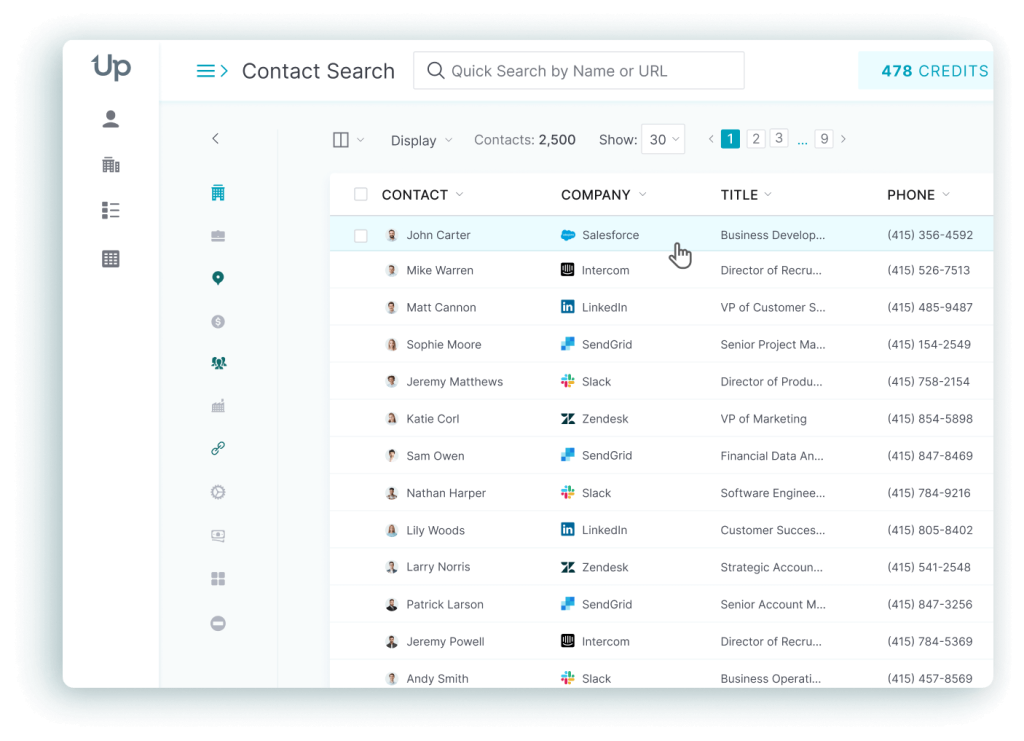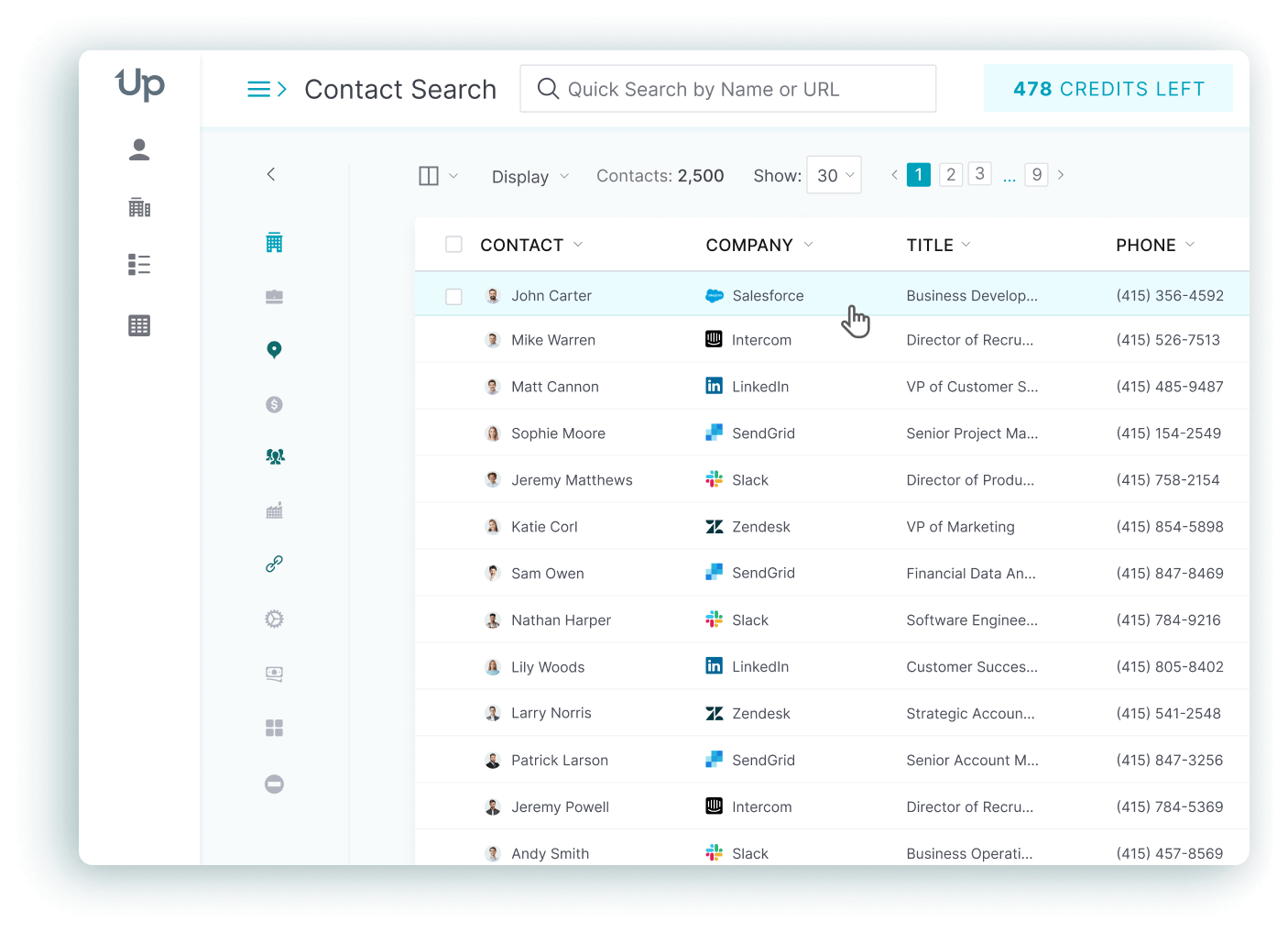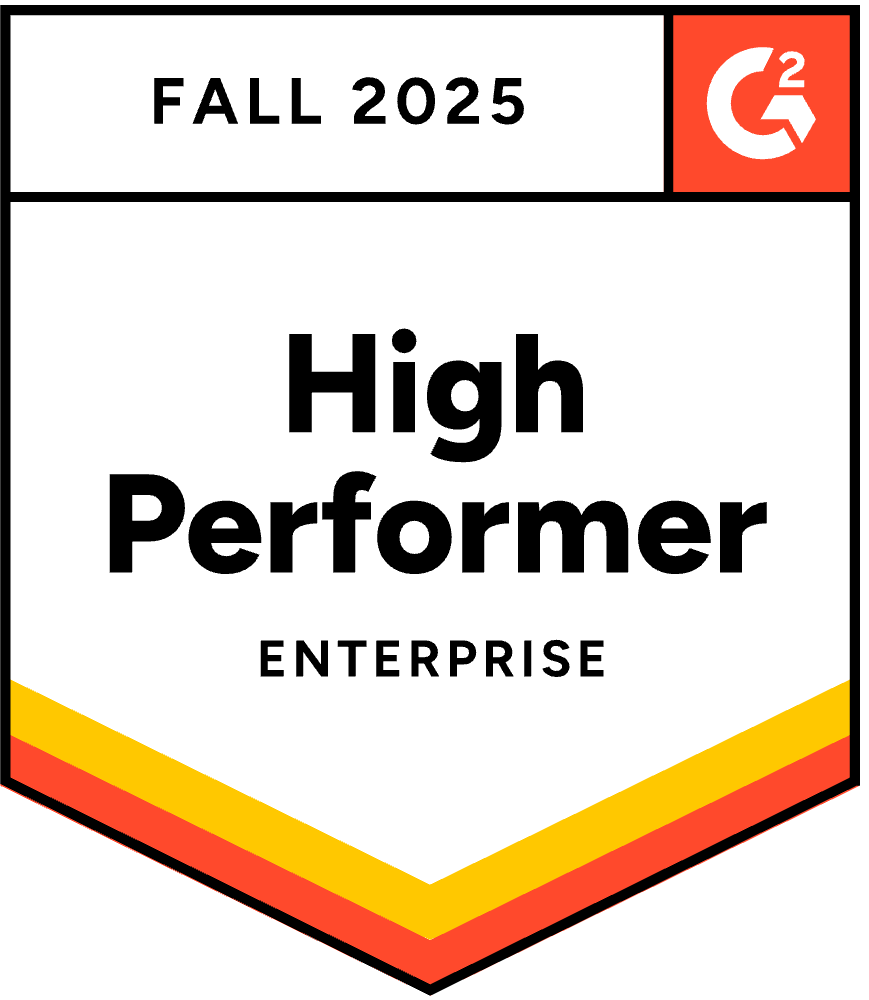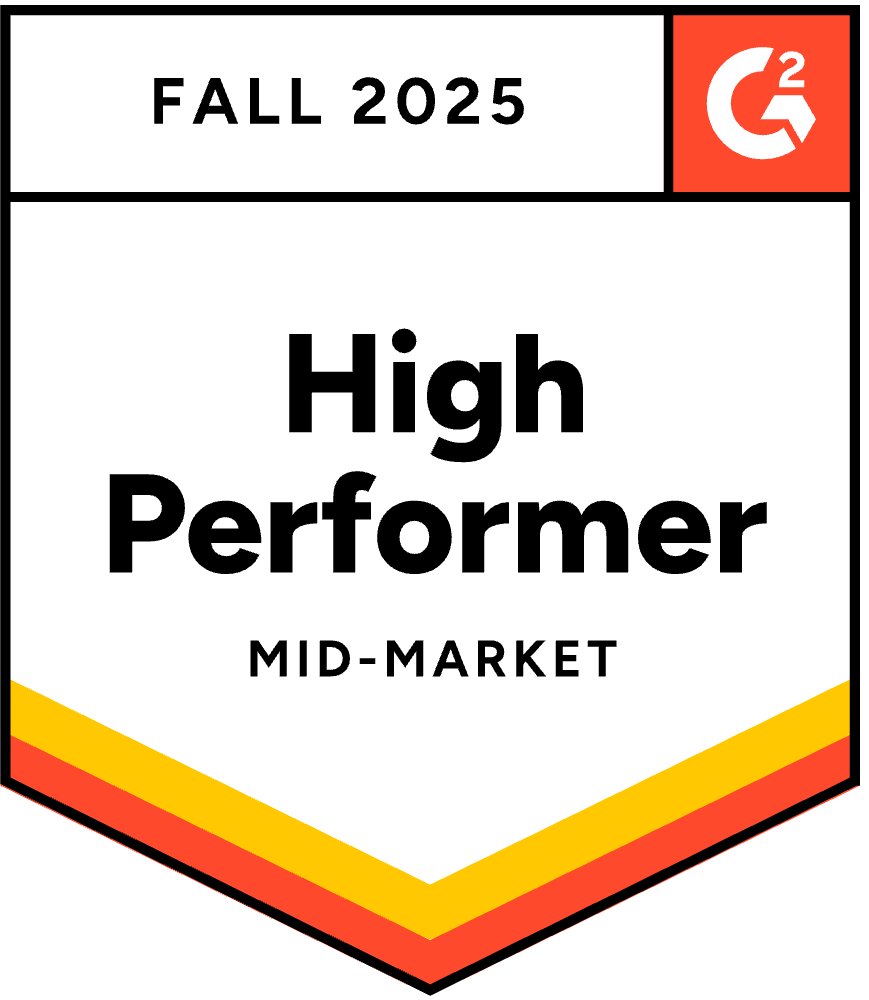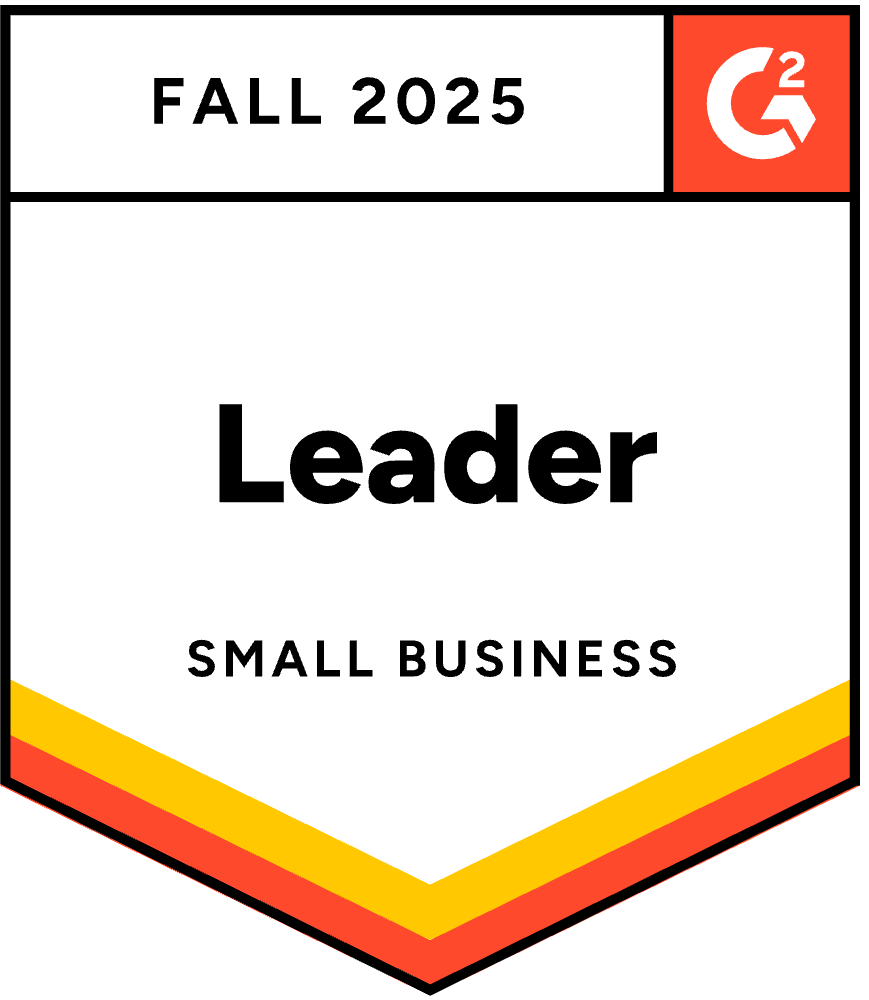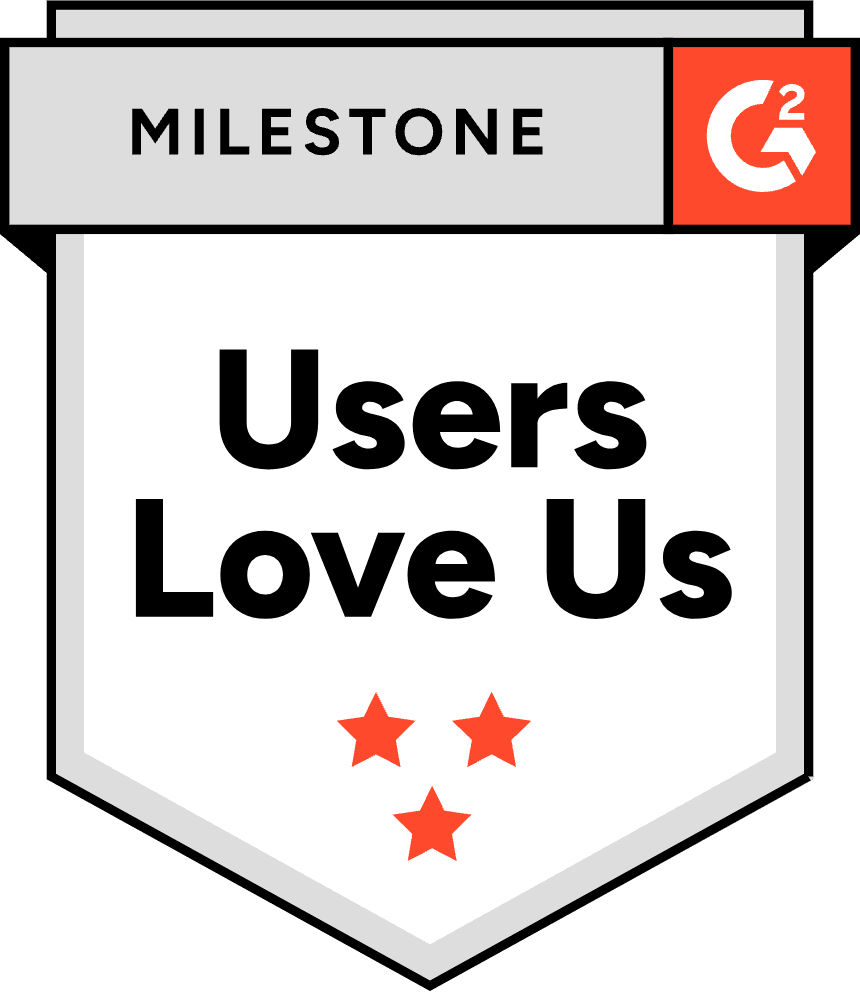Your B2B sales funnel is leaking revenue. It’s not your sales team’s fault; with B2B buyers spending only 17% of their entire customer journey meeting with potential suppliers, and even less (5-6%) with any single sales rep, the majority of their time is spent on independent market research. This trend is accelerating, as Gartner now predicts 80% of B2B customer interactions will occur in digital channels by 2025, making your sales funnel stages more critical than ever for business growth.
This guide isn’t another fluffy overview. It’s a data-driven playbook for building and optimizing a successful sales funnel that turns that chaos into predictable revenue through effective marketing and sales efforts, backed by real experiments using UpLead’s 95% accurate customer data.
We’ve rounded up the essential tips for creating a solid, well-performing sales funnel that will net you more qualified leads and convert prospective customers into paying customers.
We’ve also included our favorite templates and tools to help you build a sales funnel, plus some real-world examples of powerful sales funnel strategies you can turn to for ideas.
Ready to get started? Continue reading or jump to a specific topic below:
What is a Sales Funnel?
A B2B sales funnel is a strategic framework that maps the customer journey a potential business customer takes from initial awareness to making a purchase. It helps sales teams and marketing efforts visualize the sales process, identify drop-off points, and forecast revenue by tracking how leads move through sales funnel stages like Awareness, Consideration, and Decision.
The sales cycle length (and the number of stages) generally depends on your industry and company’s sales model, but the purpose is the same: to chart the transformation of potential customers into loyal customers through a well defined sales funnel.
What Is the Difference Between a Sales Funnel, a Marketing Funnel, and a Customer Journey?
The difference between a sales funnel, marketing funnel, and customer journey lies in their perspective and scope. A marketing funnel is a company-centric model representing a structured, linear path designed by a business to guide potential buyers from initial awareness to a specific conversion or purchase. It focuses on optimizing company-led customer interactions like ads and email marketing campaigns to maximize sales success.
A sales funnel, often used interchangeably with the marketing funnel, is more specifically focused on the final sales funnel steps of converting qualified leads into paying customers. It represents the direct journey from prospect to deal closure, managed by sales reps and the sales team.
A customer journey is a customer-centric model that encompasses the entire customer lifecycle, often non-linear, experience a customer has with a brand. It includes all touchpoints before, during, and after a purchase, including organic customer interactions not controlled by the company, such as social media engagement, customer feedback, and word-of-mouth that influence customer behavior.
Think of it like a travel agency analogy: The marketing funnel is the travel agency’s brochure and sales process, the sales funnel is the final booking process, and the customer journey is your entire travel experience from initial dream to post-trip recommendations that build customer loyalty.
Is the Traditional Sales Funnel Dead? (The Flywheel Model Explained)
The traditional sales funnel isn’t dead, but it’s evolving to better understand customer preferences and modern buying behavior. The Flywheel model is a customer-centric alternative where satisfied customers feed business growth, contrasting the linear funnel that ends at purchase. While the basic sales funnel assumes customers exit after buying, the flywheel recognizes that existing customers become advocates who attract new prospects through brand loyalty and positive customer engagement.
The Flywheel model consists of three stages: Attract (drawing in prospects with valuable content marketing efforts), Engage (building relationships and trust through the sales pipeline), and Delight (exceeding expectations to create advocates that improve customer retention). The key difference is that energy from satisfied customers powers the entire cycle, creating momentum that reduces acquisition costs over time.
For business-to-business companies, both models have merit. Use the proper sales funnel for predictable lead generation and conversion tracking, but adopt flywheel thinking for customer retention and referral programs that leverage existing customers. The most successful B2B companies combine both approaches in their sales strategies.
What Are the Key B2B Sales Funnel Models? (AIDA vs. TOFU/MOFU/BOFU)
The key B2B sales funnel models are AIDA and TOFU/MOFU/BOFU, each serving different strategic purposes in your marketing strategy. The AIDA model was developed by American advertising pioneer E. St. Elmo Lewis in 1898, originally conceived to optimize sales calls and personal selling. AIDA stands for Attention, Interest, Desire, and Action.
The TOFU/MOFU/BOFU framework segments a marketing or customer funnel into three distinct stages to align marketing tactics with the buyer’s intent and decision-making process. TOFU (Top of Funnel) corresponds to the awareness stage with educational content marketing like blog posts and infographics. MOFU (Middle of Funnel) corresponds to the ‘Consideration’ phase with in-depth content like case studies and webinars. BOFU (Bottom of Funnel) corresponds to the ‘Decision’ phase with product-focused content like demos and testimonials.
Here’s how they align in your sales funnel work:
- AIDA Attention = TOFU Awareness: Blog posts, social media posts, SEO content to generate awareness
- AIDA Interest = MOFU Consideration: Whitepapers, webinars, case studies for nurturing leads
- AIDA Desire = Late MOFU/Early BOFU: Product demos, free trials to engage potential customers
- AIDA Action = BOFU Decision: Proposals, contracts, purchase to convert potential buyers
Most B2B companies use TOFU/MOFU/BOFU for content marketing strategy and AIDA for sales conversations and email marketing sequences to better understand each stage of the sales process.
Why Do You Need a Sales Funnel?
With B2B customers now interacting with suppliers via ten or more channels, which has doubled from five channels in 2016, your digital sales funnel stages are your new sales floor. According to Gartner’s foundational ‘Future of Sales’ research, 80% of B2B sales interactions are predicted to occur in digital channels by 2025, a forecast originally made in 2020 and consistently reaffirmed in subsequent analyses. This shift is driven by growing buyer preferences for digital and self-service journeys that allow them to research pain points and solutions independently.
An effective sales funnel is the perfect opportunity to prove your worth to your target audience. You get to provide loads of value before the user has even tried your product through strategic content marketing efforts. They have the chance to get to know you—the humans behind the product. And that builds trust, which leads to purchases and helps to scale sales and achieve sustainable business growth.
According to The Annuitas Group, nurtured leads make 47% larger purchases than non-nurtured leads, proving the ROI of a well-managed customer funnel. Companies that automate lead nurturing can generate 50% more sales-ready leads at a 33% lower cost through their marketing efforts.
Some businesses are built solely around email and social media marketing. So you’re losing money if you don’t have a sales funnel that effectively moves potential customers through the buying funnel.
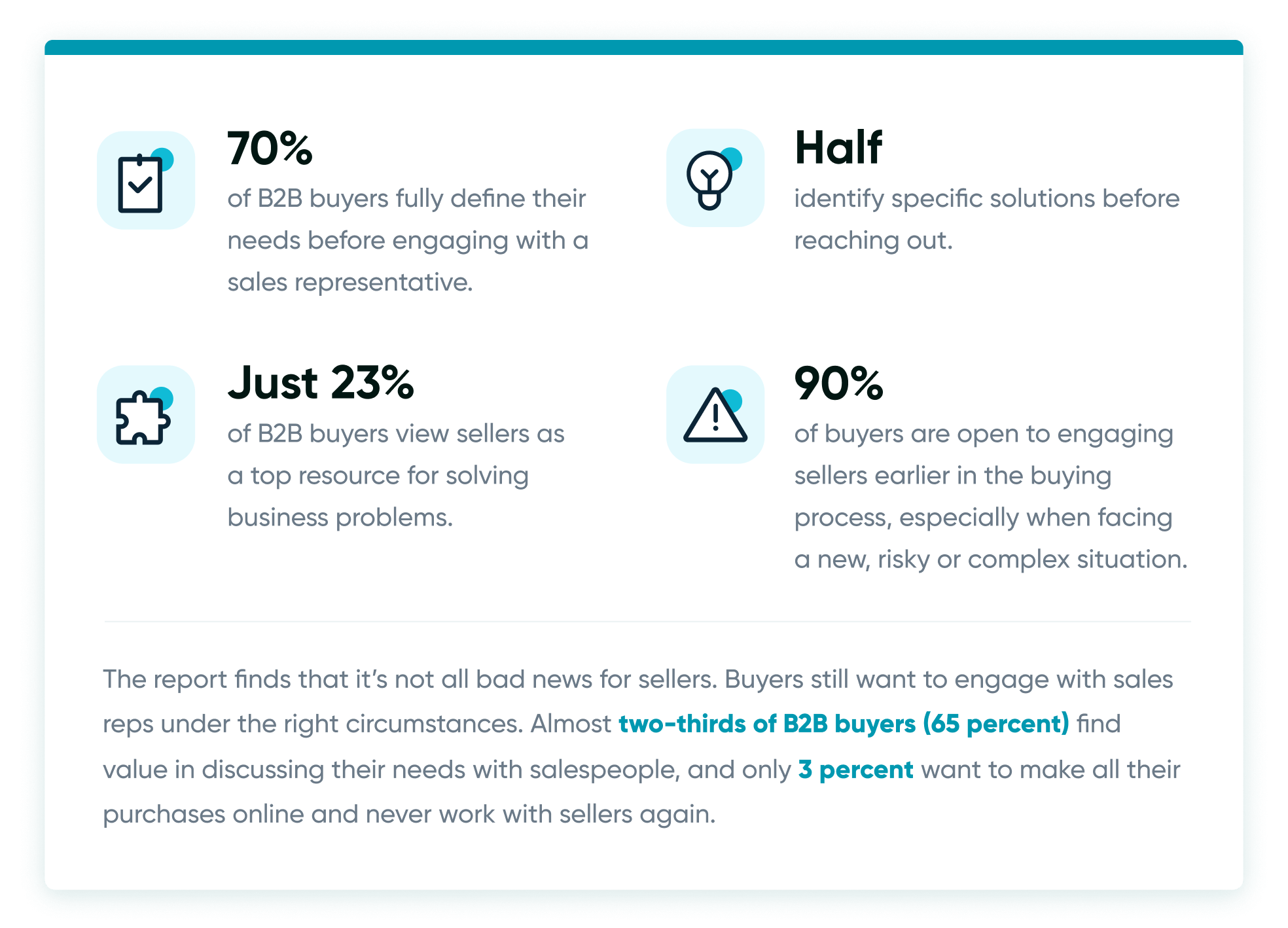
What Are the 4 Key Stages of a Modern Sales Funnel?
The 4 key stages of a modern sales funnel model are Awareness, Consideration, Decision, and Loyalty. This framework reflects how B2B buyers actually move through their purchasing funnel, with each stage requiring different content marketing, marketing tactics, and sales funnel metrics to effectively engage target customers.
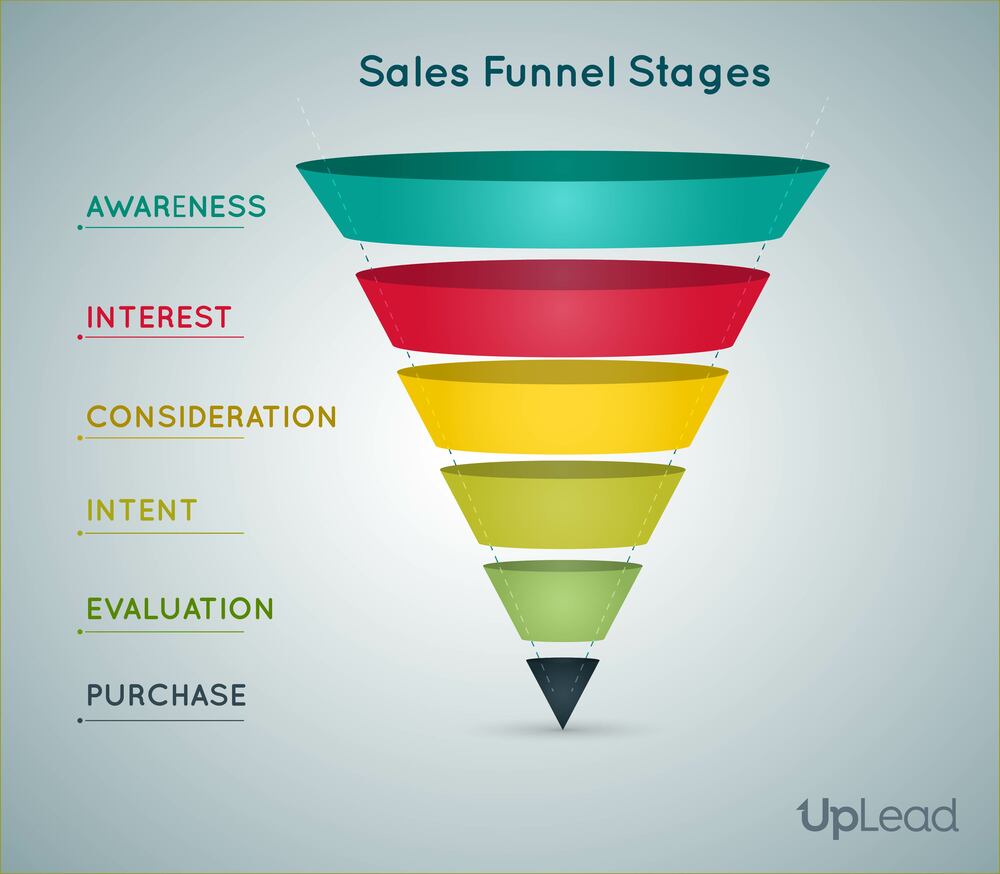
The number of sales funnel stages depends on your service and how your sales funnel work aligns with customer behavior. But we’ll cover that in the next section.
For now, let’s look at each stage of the funnel in a typical sales funnel and the purpose of each stage in converting prospective customers.
Sales Funnel Stage #1: Awareness
At this stage, your target customers are first introduced to you. It could be through an ad, a blog post, a cold email you’ve sent out, or social media content. If you conducted your market research and buyer personas research the right way, you should be able to capture many leads early on by creating targeted content for buyers in the awareness stage of their decision making process.
However they hear about you, they’re now aware that you exist and can potentially solve their pain points. Ideally, they’ll transition to the next step in your purchasing funnel through strategic marketing campaigns designed to increase brand awareness.
UpLead in Action: Use UpLead’s Prospector to build a hyper-targeted list of ‘Marketing Directors’ at ‘SaaS’ companies in the ‘US’ with ’51-200 employees’ using over 50 search criteria. UpLead provides access to over 160 million contacts across 200+ countries with 95% data accuracy and real-time email verification to help you identify your ideal target audience.
Sales Funnel Stage #2: Consideration (Interest Stage)
Whether they’re reading an ad or an email, the content must draw them in and generate genuine interest. Get them interested in how you can address their specific pain points through your sales efforts.
If you go the lead magnet route in your marketing strategy, you’ll want them to sign up for whatever it is you’re giving away for free. For example, it could be an exclusive report, an ebook, a webinar, or even an attractive landing page with valuable content marketing.
However, having a user sign up for your lead magnet is a clear indication of their interest and movement through the interest stage. And then it’s time to nurture that interest through strategic customer engagement and targeted marketing efforts.
UpLead in Action: Filter your prospect list to include only companies that use HubSpot with UpLead’s Technographics feature, which tracks over 16,000 software and tools. Send them a targeted campaign about your HubSpot integration to better engage potential customers based on their current technology stack.
Sales Funnel Stage #3: Decision
After consuming a valuable piece of info like your lead magnet, a prospect should already be heading toward the consideration stage of the sales funnel. But, to help things along and optimize this stage of the sales process, we have the nurture campaign.
It’s a series of emails designed to ease the user into consideration and push them towards intent through personalized customer interactions. A typical nurture sequence contains between 5 and 20 emails that address different aspects of the customer’s decision-making process. Remember that you can personalize cold emails at scale using automated outbound email tools based on customer data and behavior.
This stage of the sales funnel is the perfect opportunity for your sales reps to expand on the value of the lead magnet and give your leads a little more before they reach the home stretch of your sales pipeline.
UpLead in Action: Identify which of your target accounts are actively searching for ‘lead generation tools’ this week using UpLead’s Intent Data feature. Prioritize these prospects showing buying signals for immediate outreach and personalized customer engagement.
Sales Funnel Stage #4: Loyalty
They buy your product and become paying customers. But your sales funnel work doesn’t end here – this is where customer retention strategies become crucial.
If they reach this stage and don’t buy, you can add a downsell sequence at the bottom of the funnel. This will encourage them to opt for a cheaper service or product if available, giving you another chance to convert potential buyers into customers.
Or, if they make a purchase, an Upsell sequence could end the funnel for you. This sequence won’t hit them immediately but only after they’ve gotten comfortable with your product or service and you’ve built strong customer loyalty.
Once they start to realize the true value of your product or service and become satisfied customers, they’re more likely to buy again and start with the sales process all over, contributing to improved customer retention and higher customer lifetime value.
UpLead in Action: Enrich your list of current SMB customers using UpLead’s Data Enrichment API to identify which ones have recently grown to over 250 employees, flagging them as prime candidates for your enterprise plan and potential upselling opportunities.
Lead generation doesn’t have to be all that painful. With UpLead, you can easily connect with high-quality prospects and leads to grow your company.
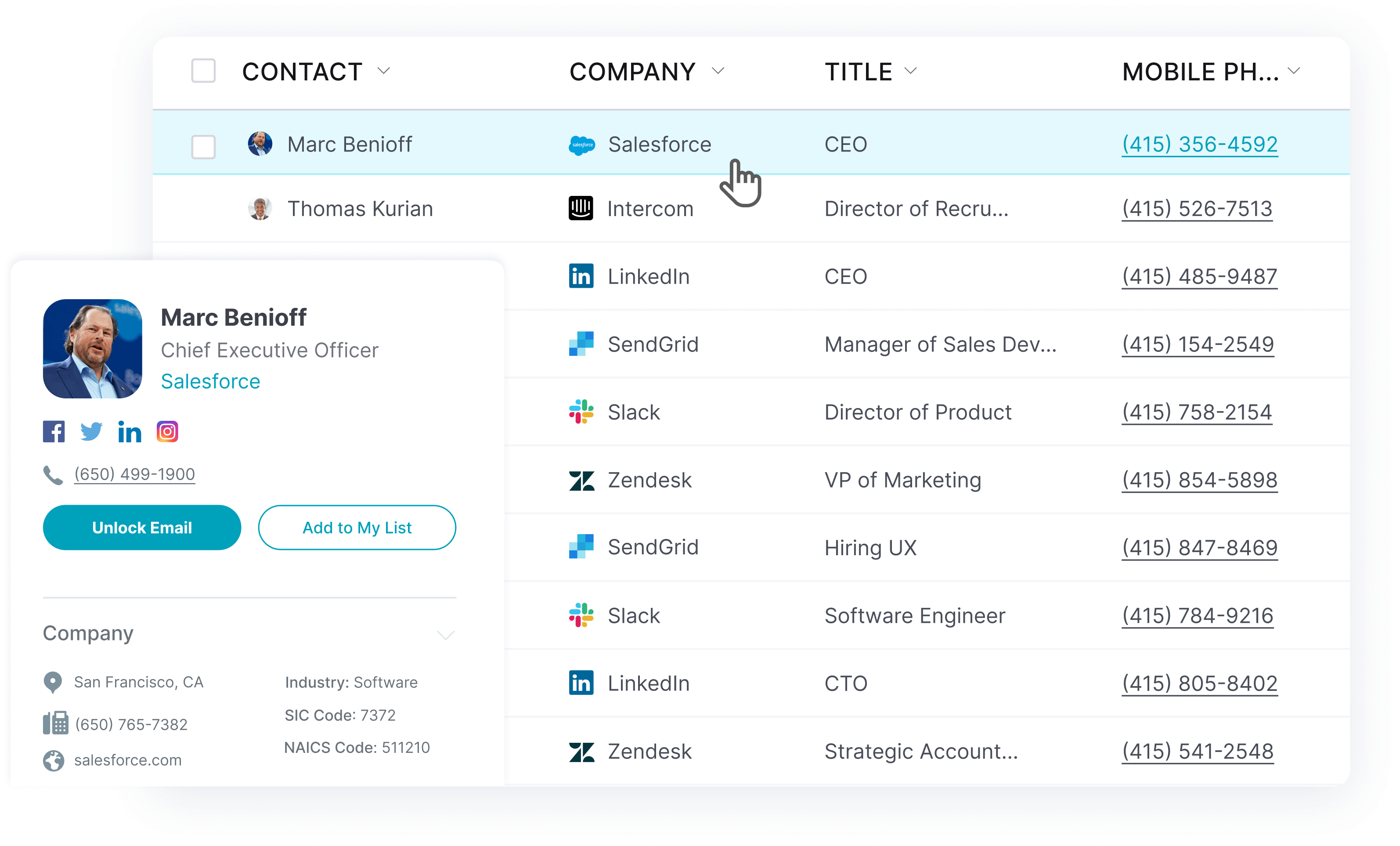
How are Sales Funnels Measured? The Key B2B Metrics That Actually Matter
Sales funnel metrics are measured through key performance indicators that track leads, conversion rates, customer lifetime value, and cycle time. Tracking these granular sales funnel metrics transforms your funnel from a black box into a predictable engine, allowing you to see exactly where deals are stalling and how to fix it for better sales success.
Your effective sales funnel should track multiple metrics at each stage to ensure your strategies are working. Here are the essential metrics organized by funnel stage:
Core Foundational Metrics
These four foundational metrics form the backbone of your sales funnel analysis:
- Leads Entered
- Conversion Rate
- Customer Lifetime Value & Conversion Cost
- Sales Cycle Time
Obtaining accurate figures for each of these methods will enable more predictable forecasting and help you understand how well your sales funnel work is performing. In turn, this tactic helps determine when it’s crunch time and when it’s okay to focus on less valuable but equally important endeavors.
Advanced Stage-Specific Metrics
Beyond the core four, these advanced metrics provide deeper insights into each stage of your sales funnel:
Top-of-Funnel to Middle-of-Funnel Metrics
MQL to SQL Conversion Rate: The percentage of Marketing Qualified Leads that become Sales Qualified Leads through your sales pipeline. Formula: (Number of SQLs / Number of MQLs) x 100. Average benchmarks range from 10% to 20% for most business-to-business companies.
Middle-of-Funnel Metrics
Lead Engagement Score: A numerical score based on customer behavior and actions like email opens, website visits, and social media interactions. Formula: Lead Score = (Action A x Weight A) + (Action B x Weight B) + …
Demo-to-Meeting Rate: Percentage of completed demos resulting in subsequent meetings with your sales team. Formula: (Number of Post-Demo Meetings Booked / Number of Demos Completed) x 100
Bottom-of-Funnel Metrics
Opportunity-to-Win Rate: Percentage of qualified opportunities that close and become paying customers. Formula: (Number of Won Opportunities / Total Closed Opportunities) x 100. Benchmarks range from 20-50% depending on industry and how well your sales funnel strategies align with market trends.
Average Deal Size: Average revenue per closed deal from your target customers. Formula: (Total Revenue from Won Deals) / (Number of Won Deals)
Overall Health Metrics
Customer Acquisition Cost (CAC): Total cost to acquire a customer through your marketing and sales efforts. Formula: (Total Sales & Marketing Expenses) / (Number of New Customers Acquired)
Customer Lifetime Value (LTV): Total profit from a customer relationship over their entire customer lifecycle. Formula: (Average Revenue Per Account) x (Customer Lifetime) – CAC
Funnel Leakage Rate: Percentage of potential customers lost at each stage of the funnel. Formula: (Number of Leads Lost at Stage / Total Leads Entering Stage) x 100
But how do we measure each metric? And how do we connect the dots to optimize our sales funnel-based approach? Let’s examine the four foundational metrics in detail:
1. Leads Entered
Arguably, this metric covers the most important metric in your sales funnel. If you don’t have qualified leads, the best salesmanship in the world is useless for converting prospective customers.
The total number of leads is measured when you enter them into your sales funnel—according to the category (types of leads) and how they interact with your marketing campaigns. Here’s an example:

This metric will tell you how healthy your top-of-funnel is and how well your content marketing efforts are attracting your target audience. Your focus needs to be here if you’re not getting enough leads through your awareness stage activities.
2. Conversion Rate
Essentially, your conversion rates plus the number of leads you’ve entered equals your sales success. And it’s simple to measure. Take your conversions, divide them by your leads, and multiply them by 100 to understand how well your sales funnel work is performing.
In this example, let’s say we raked in 170 new paying customers in the same period the above leads entered our buying funnel.
So 170 / 2,946 x 100 = 5.77%.
However, this tactic is ridiculously simple. Remember to consider leads that have completed the sales funnel stages for an accurate conversion rate, or you’ll get skewed results that don’t reflect true customer behavior.
And finally, remember that end-of-funnel conversions aren’t the only conversions that should be measured in your sales pipeline.
If you have a multi-step qualification process, it’s important to note how many leads move on to each new stage of the sales process. This way, you’ll know where your focus needs to be. An example:

So here, we see that Stage 2 is a problem since it has the sharpest drop-off in leads. But the end-of-funnel conversions are excellent. So it’s worth focusing on this stage of the sales to determine if:
- The potential customers are dropping off because of poor copy or sales tactics that don’t align with customer preferences.
- Unqualified leads are being removed from the sales funnel (possibly to be downsold or nurtured further through email marketing).
Based on the results and customer feedback, we’ll determine a path forward to improve customer engagement.
But enough about conversions and how your sales funnel work impacts your bottom line.
3. Customer Lifetime Value & Conversion Cost
These two important metrics are combined because they go hand in hand when evaluating your sales funnel strategies. They’re used to calculate profits, which is what we work for, right?
Customer lifetime value is easy for one-off purchases from your target customers. Simply attach the product’s value to the customer. Your business can get more complicated with more moving parts, such as manufacturing and staff costs that impact your overall customer data analysis.
But let the accountants worry about these details and focus on sales and how your effective sales funnel converts prospects.
Say you’re selling a software service to your target audience. And you charge $250 per month. Initially, a customer is worth $250.
Next, we want to determine how long a customer usually stays with us and contributes to customer retention. Let’s say the average amount is 8 months. (By the way, that length of time is too short for optimal customer loyalty, so we should look for the cause of the problem and improve customer retention!) We could work it out as 8 x 250. But if things suddenly change for the worse, we’ll need to redo all our calculations.
So let’s look at 6 months to be conservative in our customer lifecycle calculations. It’s better to lowball than overestimate, I always say.
So 6 x 250 = $1500. That’s our Customer Lifetime Value. That’s great and all, but pretty useless to us on its own when evaluating our sales funnel work.
Conversion Cost
Pretty self-explanatory. What does it cost us to drive a lead through our sales funnel stages and get the sale from potential buyers? This includes all marketing and sales efforts, from social media marketing to email marketing costs.
Let’s look at a table that shows how our marketing campaigns perform:
Before we continue, here’s how I got these figures for evaluating our sales funnel based performance:
Cost Per Lead = (Cost + Funnel Maintenance Cost) / Leads
Cost Per Conversion = (Cost + Funnel Maintenance Cost) / Conversions
Profit = (Customer Lifetime Value – Cost Per Conversion) x Conversions
Let’s think about a couple of sales funnel examples and how our marketing tactics impact costs. Say we’re paying a small sales team $4,000 monthly to manage our sales funnel and customer interactions. We can split these costs equally across the avenues. Or split them according to the percentage of conversions. It’s up to you.
Anyway, we can see that we’re making huge profits on our funnel through both entry points. The website is making a more raw profit, but it’s harder to scale than social media ads that target our buyer personas.
Then there’s a final metric to take into the calculation: the initial sales funnel cost. Let’s say we get a good copywriter to set the funnel up for our target customers for $20,000. According to the chart above, we made a huge ROI this quarter through our sales funnel strategies.
ROI = Profit / Initial Cost
So we’ve already achieved an ROI of 19 through our effective sales funnel. Nice.
4. Sales Cycle Time
This metric is important for forecasting and understanding customer behavior throughout your sales pipeline. How long does it take from when a lead finds your landing page until they purchase your service and become paying customers?
Let’s say it takes 30 days for prospects to move through your sales funnel stages. In that case, you can make accurate monthly forecasts based on your current customer data.

This outcome creates simple forecasting, and as you can see, you’re looking good next month for converting more prospective customers.
How to Build Your B2B Sales Funnel in 6 Steps (A Data-First Approach)
Building your B2B sales funnel involves defining your target audience, mapping their customer journey, creating content for each stage, and driving traffic through strategic marketing efforts. Creating a data-first approach ensures every decision is backed by customer insights and measurable outcomes from your buyer personas research.
Step 1: Define Your Ideal Customer Profile (ICP) and Pain Points
You’ll need a good offer to kickstart your sales funnel stages and attract your target customers. The first step is to figure out what to offer your target audience based on their specific pain points and then create it through strategic content marketing efforts.
It’s important that your lead magnet doesn’t contain information readily available online. If it’s a struggle to find all the information and put it together, that’s fine. However, if potential customers can find the information in your lead magnet through a simple Google search, it won’t be very valuable to them or effective in your buying funnel.
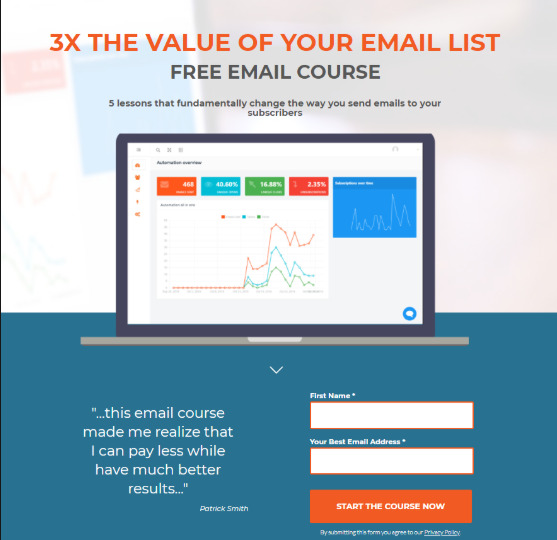
This mistake would destroy the customer engagement before it even starts. Their opinion of you would be set, and they’ll likely unsubscribe from your list at the first opportunity, damaging potential customer loyalty.
The lead magnet must provide deep insight or real value to be effective in your sales pipeline. Ideally, the user can hardly believe it is free, and it motivates them to become paying customers through your sales funnel work.
There are several types of lead magnets to engage potential customers. A landing page with a free trial or initial call is the most common. But here are a few (better) ideas for your marketing strategy:
- An ebook that addresses specific pain points (can be sold on Amazon as well, to give the impression of even greater value)
- A detailed report on market trends or something truly important to your target customers
- A video course to learn a new skill relevant to your buyer personas
- A free subscription to a valuable in-house magazine that provides ongoing customer engagement. (Ideally, it’s a physical magazine.)
- A webinar, where prospective customers could learn a new skill or tactic relevant to their business challenges
And so the list goes on for nurturing leads. Your imagination only limits you. Once you’ve created a lead magnet, there’s no need to stick to it for life. You can always change it later based on customer feedback and market research. So don’t procrastinate during this step; your sales funnel stages and customer lifecycle will never be finished. For now, create something to begin building your sales funnel.
Step 2: Map the Customer Journey and Sales Funnel Stages
Building leads by creating and maintaining a blog for your sales funnel stage needs and content marketing efforts isn’t easy. But it can be rewarding for business growth, especially if you also decide to monetize your blog through other methods that complement your sales strategies.
But most of us focus on getting qualified leads through the blog to feed our sales pipeline. So here’s the way to get your blog rolling for your target audience:
Step 3: Create High-Value Content & Lead Magnets for Each Stage
Content Marketing Strategy
First, write out a list of topics your potential customers would be interested in based on their pain points and customer preferences. You need to know your target customers well for this step, so do some market research before you start your content marketing efforts.
Take a few days to jot down ideas as they come, considering different market trends that might affect your buyer personas. Once you have as many topics as possible (200+ is ideal for comprehensive content marketing), it’s time to turn those topics into gold.
Use a research tool like Keywords Anywhere to find keywords related to your chosen topics and customer behavior patterns. Adapt them according to the keywords you want to rank for to increase brand awareness. Delete the topics that don’t hold any SEO value for your target audience.
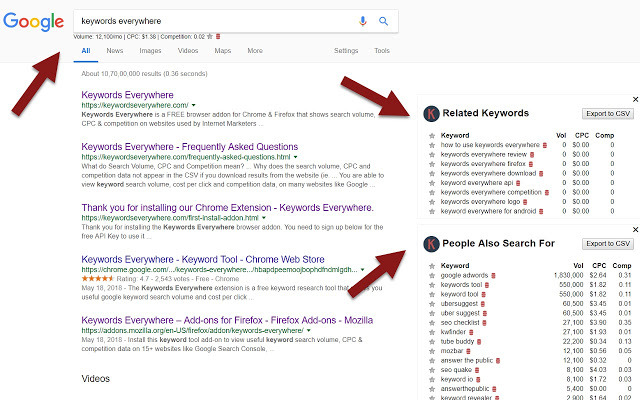
(Source: Keywords Everywhere)
Now place these topics on a content calendar and start writing content that addresses specific pain points and engages potential customers through valuable customer interactions.
Step 4: Drive Targeted Traffic to the Top of the Funnel
Marketing Campaigns and Social Media Strategy
For paid advertising and social media marketing, the first step is to choose your platform based on where your target customers spend their time. It’s up to you whether it’s Facebook, LinkedIn, or another social media platform that aligns with your buyer personas.
The basics remain the same for your marketing tactics. Create several ads to test against one another to determine which ones are better for which sales funnel stages and customer behavior patterns. Once you’ve found a few that work for engaging potential customers, scale them up and check the effect on conversions/sign-ups. Then rinse and repeat with your social media strategy.
Different platforms have different rules and audience behaviors. So make sure to research what’s working on your chosen platform for your target audience and take it from there to optimize your social media posts.
Before you start testing front-end ads and social media campaigns, it’s wise to complete the rest of your funnel and ensure your sales process is optimized…
Step 5: Implement a Lead Nurturing and Follow-Up Process
Is your product or service high-end? Then you’re likely to need a longer nurture campaign in your sales funnel to build customer loyalty and trust with your target customers.
Are you more affordable? Make it shorter and focus on converting potential buyers more quickly.
Your customer lifetime value will impact most of what you do throughout your funnel and how you approach nurturing leads, but we’ll take a look at that in the next section.
Your nurture campaign can now include anywhere from 5 to 30 emails to engage potential customers. After 30 emails, it’s really more of a newsletter that focuses on ongoing customer engagement, right?
Figure out what you need to do to earn your lead’s trust through customer interactions, and do that. Two proven ways to build trust and improve customer engagement are testimonials and case studies. As long as you successfully connect with your prospect on a human level and address their specific pain points, your nurture campaign is a success.
At this point, you’ll also want to choose email marketing software if you don’t have one already for managing customer data. Good places to start are Mailchimp and Klaviyo. If you wish to try other email marketing tools, you can look at some of the top Mailchimp alternatives that might better serve your target audience.
Step 6: Analyze and Optimize with Key Metrics
You’ll have 2-5 email sequences and a sales page at this part of your sales funnel stages for converting prospective customers. Once your prospect has agreed to move forward in your sales pipeline, send them the sales contract. There are plenty of detailed free proposals and contract templates online if you don’t already have one for your business-to-business transactions.
No sales funnel would be complete—or even useful—without a way to measure the success of its stages and customer behavior. It would be like driving a car without a fuel gauge. You’ll only know there’s a problem after it’s too late and your customer engagement has suffered.
We’ll get deeper into what to track in a second. But here’s how to track your sales funnel and customer data effectively.
Most CRMs internally track sales funnel success and customer lifecycle metrics. However, you could add Google Analytics to your stack if you want to take things further and get deeper insights into customer behavior. It’s an invaluable tool with hosts of insights, and you can track it across platforms. So you can keep an eye on your overall funnel health and how well your sales funnel work is performing.
Some CRMs fall short in this department for tracking customer data and sales funnel metrics. Determine whether your CRM matches Google Analytics’ capabilities for measuring customer engagement, and take the necessary steps to ensure you can properly analyze your sales funnel strategies.
While building and implementing your sales funnel, it’s vital that you run constant tests on customer behavior and preferences.
Once everything is up and running, you’ll build a control group – against which you can test all future tweaks to your sales funnel and customer interactions. Then it’s time to check the results and see where the weakest performance is in your customer lifecycle. Whether the drop-off of leads is just after the lead magnet or somewhere in the middle of your sales pipeline, you’ll know where to focus your marketing efforts.
Create new materials based on customer feedback, test them against the controls, and continually refine the sales funnel to better serve your target customers and improve customer retention.
Eventually, your funnel will run like a finely tuned money machine that consistently converts prospective customers into loyal customers. And even then, some continued testing is always a good idea to adapt to changing market trends and customer preferences.
How Does Buyer Psychology Impact the Sales Funnel?
Buyer psychology impacts the sales funnel by influencing the decision-making process at each stage through cognitive biases and emotional triggers that affect customer behavior. 95% of purchasing decisions are subconscious, attributed to Harvard Business School professor Gerald Zaltman from his book ‘How Customers Think: Essential Insights into the Mind of the Market’.
Understanding these psychological principles allows you to design customer funnel experiences that naturally guide prospects toward purchase decisions and build stronger customer loyalty. Here are 5 key psychological principles to leverage in your sales funnel strategies:
Social Proof (MoFu): Provide detailed case studies, customer testimonials, and positive reviews from third-party sites. Business to business buyers rely heavily on peer validation when evaluating solutions, making this crucial for customer engagement.
Scarcity/Urgency (BoFu): Use limited-time offers like end-of-quarter discounts with countdown timers on your landing pages. This creates a fear of missing out that accelerates the decision making process for potential buyers.
Loss Aversion (BoFu): Frame offers around what they’ll lose by not acting, such as free trials where prospects face the ‘loss’ of tool benefits. People are twice as motivated to avoid losses as they are to achieve gains, making this powerful for converting potential customers.
Anchoring Bias (BoFu): Present premium pricing plans first to make standard plans seem more affordable to your target customers. The first price they see becomes the reference point for all other options in their decision making process.
Reciprocity (ToFu): Offer high-value, non-gated content like free tools and comprehensive guides through your content marketing efforts. When you give first, prospects feel obligated to reciprocate by engaging further in your buying funnel.
How Do You Automate a B2B Sales Funnel?
You automate a B2B sales funnel by mapping the customer journey, selecting automation tools, setting up workflows with triggers and actions, implementing lead scoring, and monitoring key performance indicators for customer engagement. Companies that automate nurturing leads can generate 50% more sales-ready leads at a 33% lower cost through their marketing and sales efforts.
Here’s a 5-step process to automate your customer funnel and improve customer retention:
1) Map the sales funnel stages and customer journey as the blueprint: Document every customer interaction from awareness stage to purchase, identifying where automation can replace manual tasks in your sales process.
2) Select automation tools for your marketing strategy: Choose a CRM like HubSpot’s comprehensive Customer Platform with AI-powered Smart CRM, and email marketing automation like ActiveCampaign’s autonomous marketing platform utilizing AI agents for email, SMS, and WhatsApp marketing to your target audience.
3) Set up automated workflows with specific triggers and actions: For example, whitepaper download triggers a 3-day nurture sequence, followed by a demo invitation if they visit your pricing page, creating seamless customer interactions throughout their journey.
4) Implement automated lead scoring based on customer data: Combine explicit data (+20 for Director title) and behavioral data (+25 for pricing page visit, +50 for demo request) to prioritize sales team outreach to qualified leads.
5) Monitor sales funnel metrics: Track conversion rate per stage, email marketing metrics (open rates, click rates), and sales pipeline velocity to identify optimization opportunities for better customer engagement and business growth.
How Is AI Revolutionizing the B2B Sales Funnel?
AI is revolutionizing the B2B sales funnel by automating lead generation, personalizing customer interactions at scale, and providing predictive insights for better decision-making in your marketing and sales efforts. Companies using AI report up to 50% more qualified leads and appointments, 60-70% shorter call times, and up to 60% in cost savings. AI adoption in sales teams reached 43% in 2024, a 9% increase from 2023.
Here’s how AI impacts each stage of the customer funnel and improves customer engagement:
1) Lead Generation: AI tools like Seamless.AI and Cognism automate prospecting by building targeted lead lists from firmographic, technographic, and intent data, reducing manual market research time by 80% for identifying your target customers.
2) Lead Qualification: AI automates lead scoring by analyzing historical customer data and behavioral signals, increasing lead-to-customer conversion rates by 20-40%. Tools include HubSpot’s AI-powered Smart CRM and Salesforce Einstein for better sales pipeline management.
3) Hyper-Personalization: Generative AI creates customized outreach at scale using tools like Lavender and Regie.ai, increasing customer engagement rates by 35%. AI analyzes prospect data to craft personalized emails that reference specific pain points and use cases for your target audience.
4) Conversation Intelligence: AI platforms like Gong and ZoomInfo Chorus analyze sales calls to provide actionable insights and reduce manual review time by 80%. They identify successful talk tracks, objection patterns, and deal risk factors to help sales reps improve customer interactions.
5) Forecasting: AI-powered tools like Clari reduce forecasting errors by 20-30% by analyzing sales pipeline data, deal progression patterns, and external market trends that affect your business growth.
Additionally, Monday.com’s Work OS includes AI-powered lead management and scoring, AI-assisted email composition and personalization for better customer engagement, automated summarization of notes and emails, sentiment analysis of client communications for understanding customer feedback, and sales forecasting. The company reports that users performed around 10 million AI-driven actions in 2024, with usage nearly tripling each quarter.
5 Real Examples of Sales Funnels
One of the best things about sales and marketing is that we get to learn from others and their successful sales funnel strategies. And sales funnel examples are no exception for understanding how different companies approach their target customers.
So here are 5 excellent examples of sales funnels that teach valuable lessons about customer engagement and converting prospective customers:
1. Crazy Egg
Who better to learn about effective sales funnel strategies from than sales and marketing legend Neil Patel?
Crazy Egg has a great funnel that drives target customers through the buying funnel. And it all starts with their content marketing strategy and blog.
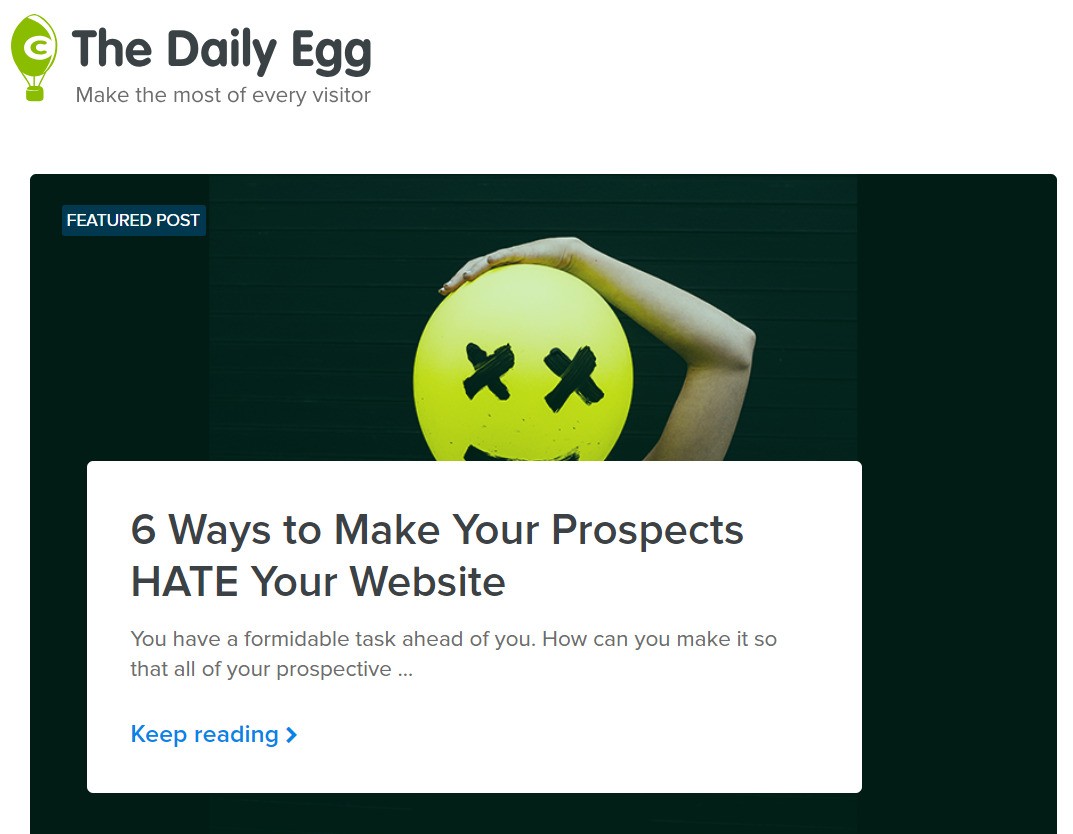
As pictured above, each blog post has a juicy headline designed to attract their target audience. And it contains valuable insights that keep readers coming back for more, building customer loyalty. Which gets them to sign up— with a good CTA at the bottom of each post that drives customer engagement:

And just like that, you enter a powerful nurture campaign: a Crazy Egg subscription that keeps potential customers engaged throughout their customer lifecycle.
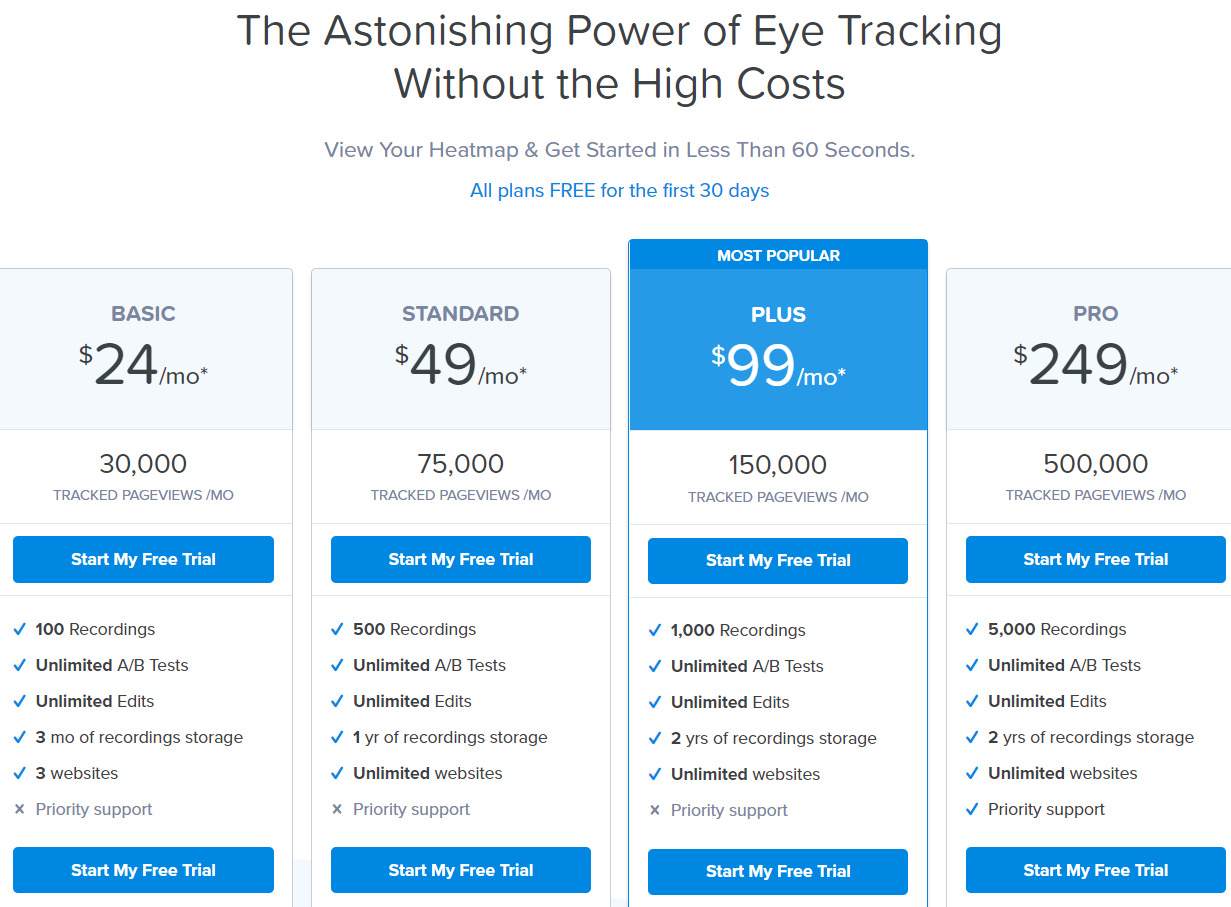
What’s Good about This Sales Funnel?
Honestly, everything about their approach to nurturing leads. But this funnel really shines in its simplicity and focus on customer behavior.
Everything is clear and as easy to understand as possible for their target customers. It makes it a perfect example for your own sales funnel work. With every piece of copy, the value proposition shines through and addresses specific pain points. And while their landing page is basically just a signup form at first, it gives you the option to learn more before you subscribe, which is a much better option than a signup page on its own for customer engagement.
How Could This Sales Funnel Be Improved?
In Crazy Egg’s customer funnel, finding something to improve upon is hard. One really has to nitpick to find something to criticize about their sales funnel strategies.
Here’s the thing: Crazy Egg has been growing its revenue every year through effective customer retention. And their sales funnel work hasn’t changed much since it first launched, proving it’s working for their target audience.
But if one thing could be slightly tweaked, it could be a tad more descriptive throughout the funnel to better address various customer preferences.
2. Harvest
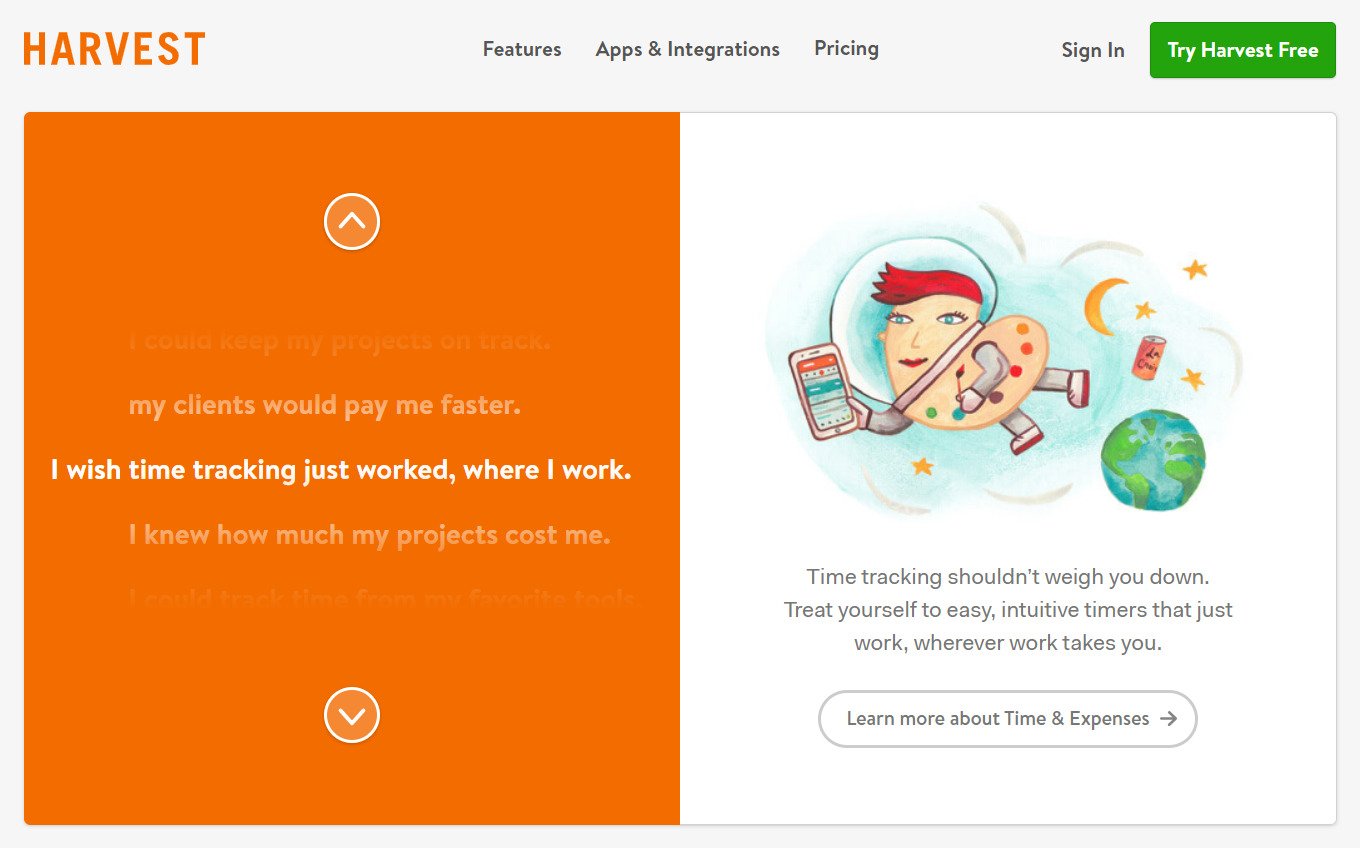
Harvest is time-tracking software that’s mainly built for companies that use freelancers, targeting a specific segment of target customers. But many in-house teams have adopted similar software as business growth continues.
Regardless, Harvest makes use of organic traffic and content marketing to speed up growth and engage potential customers.

Their blog is regularly updated with content that addresses customer pain points, which is indicative of its effectiveness in their sales pipeline. And again, there’s a clear CTA to join their mailing list at the bottom of each page for better customer engagement.
What’s Good about This Sales Funnel?
Harvest has a clear value proposition visible in all their copies that speaks directly to their target audience. Right from the start, it’s easy to understand what Harvest offers you and how it solves specific pain points for potential customers.
Personally, I haven’t seen their email marketing sequences. But judging from the quality of their top-of-funnel copy and content marketing efforts, the emails are top-quality and designed for effective customer engagement.
How Could This Sales Funnel Be Improved?
The CTA at the bottom of the blog posts could be more benefit-oriented to better appeal to customer preferences and improve customer engagement.
Currently, they have 2 CTAs at the bottom of their page that target potential customers:

Both point toward takeaways that aren’t very beneficial to users or address specific customer behavior. The question in each reader’s mind is: “What’s in it for me?” So hitting them with more personal, powerful, beneficial CTAs goes a long way toward increasing leads that enter the funnel and improving customer engagement.
It’s impressive that 50k businesses trust Harvest and shows strong customer loyalty. But the reader would probably respond better to something like “Get more time out of your day,” which speaks to their specific pain points.
3. Monday.com
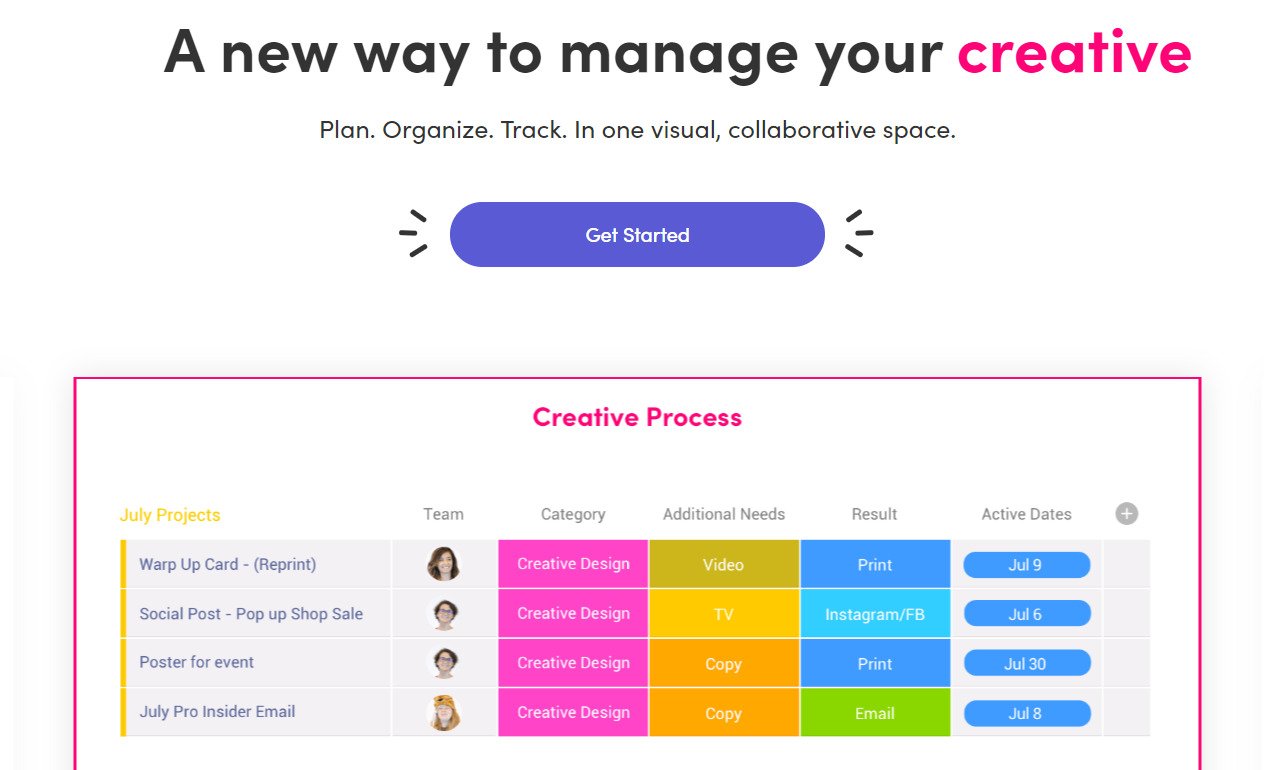
Monday immediately communicates their main benefit to target customers: Be more organized. They’ve also been running YouTube ads as part of their social media strategy that definitely drew my attention. The ads were effective in their marketing campaigns, as they mainly focused on social proof and customer testimonials.
One ad also depicted satisfying events, such as highlighting other benefits they offer to their target audience, showcasing their understanding of customer behavior.
In addition, they have a blog as part of their content marketing strategy with a CTA that scrolls down the page with you for constant customer engagement.
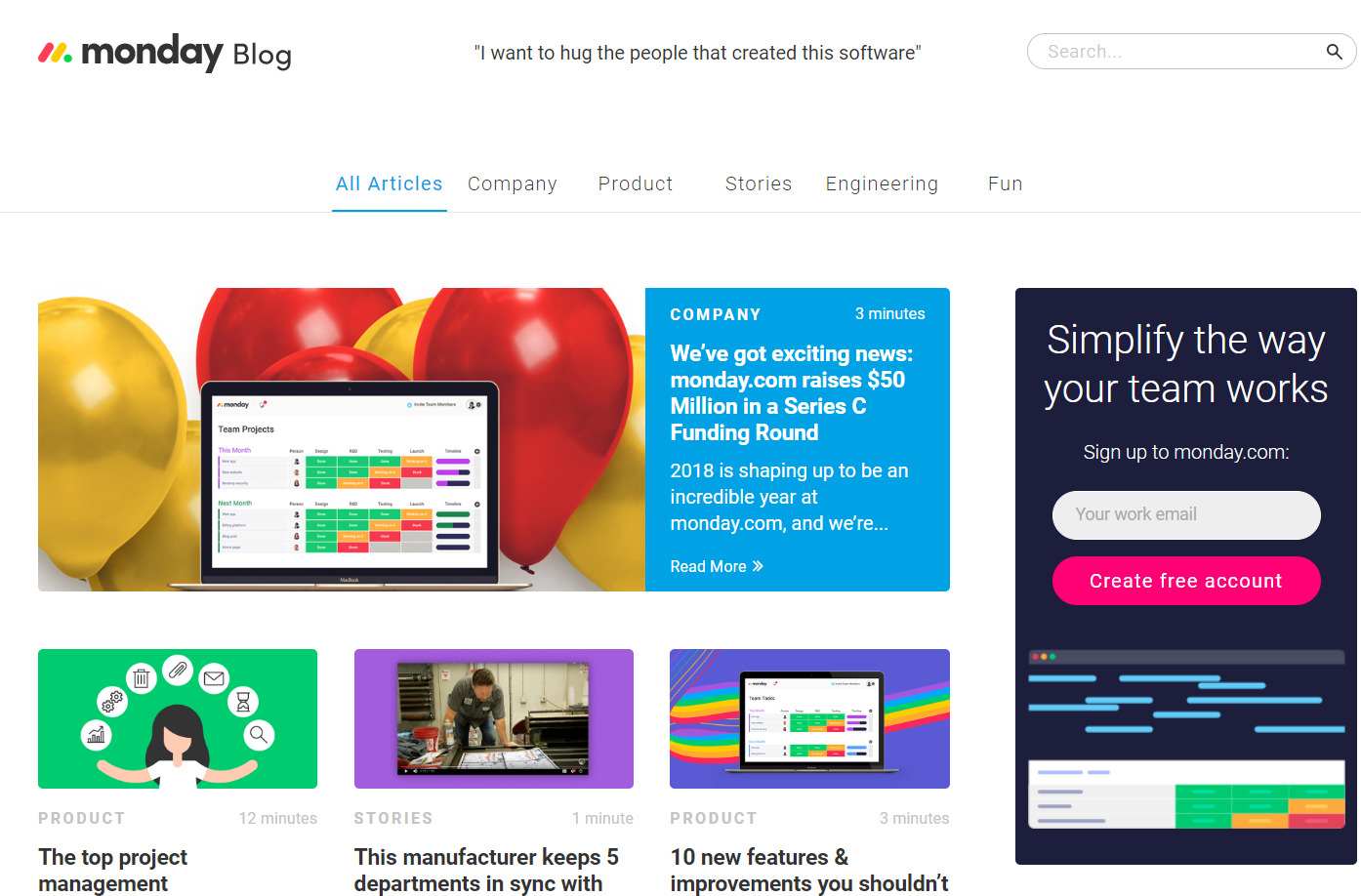
Given the frequency of posting and their comprehensive marketing efforts, they’re working very hard to scale business growth quickly and engage potential customers.
They’re certainly making waves in their market and building strong customer loyalty.
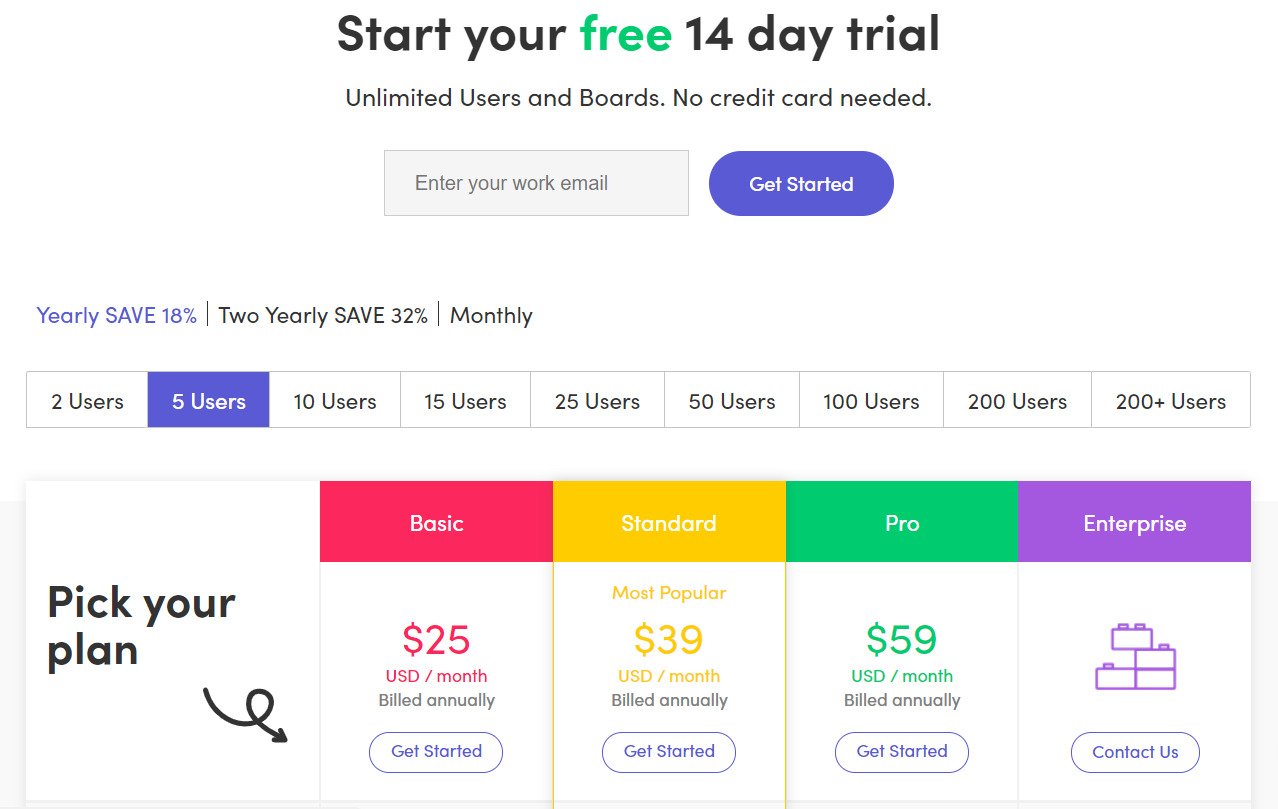
- Reminder to sign up at the end of the free trial to convert potential buyers
What’s Good about This Sales Funnel?
First, they quickly communicate the chief benefit to their target customers in their video ads and landing page. Secondly, their frequent blog posts are doing wonders for their SEO score and content marketing efforts.
Plus, the floating CTA button is a great idea for customer engagement, as it keeps the signup top-of-mind throughout the blog post, though it may be considered distracting depending on customer preferences. So before we make a final call, let’s wait and see whether they change it based on customer feedback.
How Could This Sales Funnel Be Improved?
While the headline on their landing page works well with the subtitle and imagery for their target audience, it wouldn’t be much use alone. A new way to manage your creativity doesn’t necessarily mean a better way to address customer pain points.
It would be worth experimenting with headlines that focus on specific user benefits and better understand customer behavior and preferences.
And there’s that floating CTA button that we’re still undecided on for optimal customer engagement.
4. Basecamp
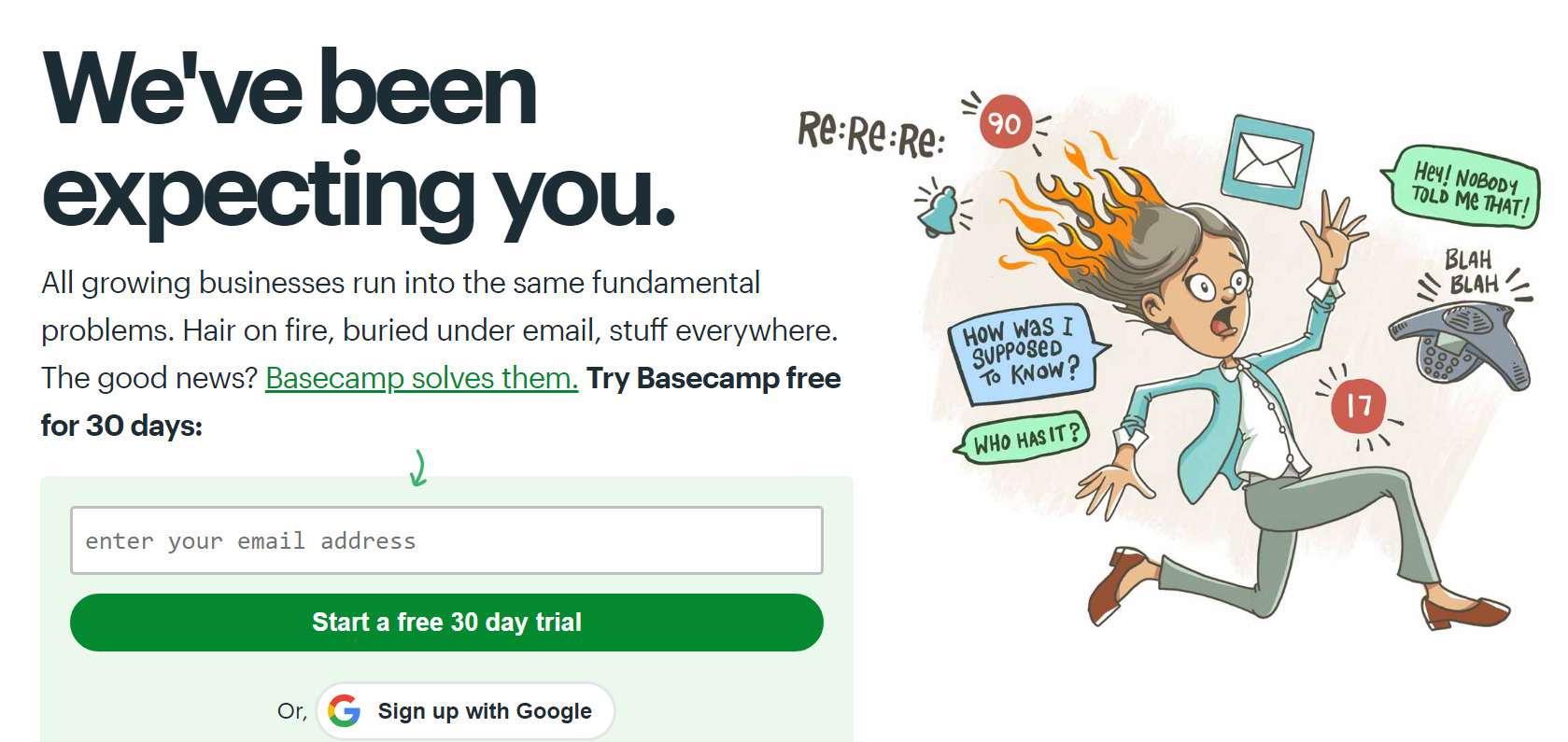
Basecamp is also a project management software with a unique copy approach for their target customers: Good humor that addresses customer pain points while building customer engagement.
Okay, business to business companies commonly attempt to use humor in their marketing campaigns. But they rarely use it to good effect without destroying the sale or damaging customer loyalty.
Basecamp speaks to the problems their target customers are having. While it makes light of the problems, it still draws attention to specific pain points. And without hesitation, it points out they can solve these problems and improve customer satisfaction.
They also have a traditionally organic funnel approach to content marketing. While they run some marketing campaigns, they also use their blog to get traffic and engage potential customers. However, it seems minimal, as some posts don’t even contain a CTA (which can be good for customer engagement).
Notably, their blog has a different brand: Signal v Noise (SVN). This tactic is odd but not unheard of in sales funnel strategies. But their blog is straightforward and focused on providing value to their target audience. No BS.
What’s Good about This Sales Funnel?
Humor is often avoided in copy targeting business-to-business customers. But every so often, a company pulls it off well and creates strong customer loyalty. And Basecamp is one of these companies.
They have a unique cartoon style for their header image that appeals to customer behavior and frequently test different designs on their landing page. But from what I can see, the same image has been featured in their marketing efforts since 2017.
And it’s easy to see why: It illustrates the problem while giving users both laughter and inspiration, fostering positive customer engagement and addressing pain points.
How Could This Sales Funnel Be Improved?
SVN is a recognized website that provides value to their target customers. Those backlinks to Basecamp are certainly good for SEO purposes and business growth. But if I could change one thing about this sales funnel work, it’d be to also keep a blog on their main website for bonus SEO points and better customer engagement.
The headline “We’ve Been Expecting You” also doesn’t do much for me or address specific customer pain points. It fits well with the style of the page and target audience. But I’d test a few different, more benefit-oriented headlines here that better speak to customer preferences.
5. Planscope.io
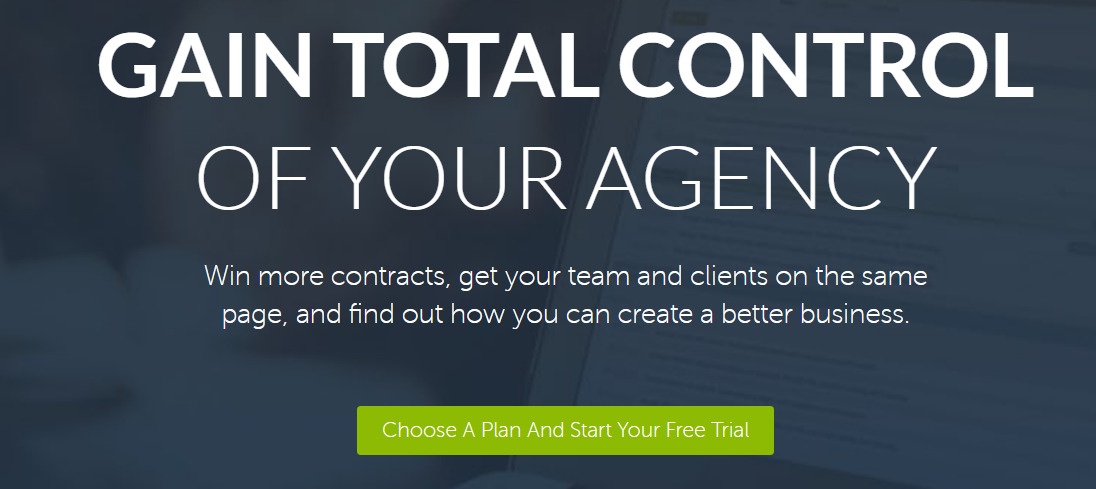
Planscope is another project management software with a focus on serving their target customers. (What’s with PM software and good copy that drives customer engagement?)
They also run a blog as part of their content marketing strategy, keeping users updated on business and software changes that might affect customer behavior.
However, they have several CTAs around the website, all pointing towards a free trial to convert potential customers into paying customers.
What’s Good about This Sales Funnel?
Their landing page probably contains one of the best headlines in the list for attracting target customers. It’s short and powerful but could be a little more specific about addressing customer pain points.
How Could This Sales Funnel Be Improved?
Undoubtedly, the blog should speak to the readers and their target customers more effectively. They want value and/or entertainment from content marketing efforts. So just posting updates about the business could quickly bore the readers based on customer preferences, and readership will drop, which will cause leads to drop and hurt customer engagement.
Given the current state of the blog and their marketing strategy, it’s safe to assume that Planescape is operating on ads and/or referrals to drive business growth.
Top Sales Funnel Examples, Templates, and Tools
The best sales funnel examples, templates, and tools provide comprehensive frameworks for different business models and automate key processes in your sales pipeline. Here’s our curated selection of proven resources to accelerate your funnel development and improve customer engagement with your target audience.
B2B Sales Funnel Examples for Different Business Models
The B2B SaaS Sales Funnel (e.g., UpLead): Awareness stage via content marketing and SEO → Consideration via webinars and product demos → Decision via intent data and free trials → Loyalty via data enrichment for upsell opportunities and improved customer retention.
The Agency/Consultant Customer Funnel: Stage 1: Awareness through thought leadership articles on LinkedIn, informational blog posts targeting specific pain points, targeted marketing campaigns, and industry podcast appearances. Stage 2: Interest stage/Consideration via downloadable lead magnets like whitepapers breaking down successful case studies, webinars teaching specific methodologies, and email marketing sequences sharing customer testimonials. Stage 3: Evaluation/Decision with “Discovery Call” or “Strategy Session” CTAs, followed by detailed, tailored proposals outlining scope, deliverables, timeline, and investment for prospective customers. Stage 4: Loyalty/Customer Retention through structured client onboarding, regular check-ins, and proactive support to generate referrals and identify upsell opportunities.
The B2B E-commerce/Wholesale Buying Funnel: Stage 1: Awareness through SEO-optimized product category pages, targeted LinkedIn ads, and email outreach to potential retailers in your target audience. Stage 2: Interest stage/Consideration via a user-friendly business-to-business e-commerce website with clear product catalogs, spec sheets, and high-quality images, requiring account creation to view wholesale pricing. Stage 3: Decision/Purchase through streamlined online ordering with bulk order forms, transparent shipping information, various payment options, and “Request a Quote” for custom pricing to convert potential buyers. Stage 4: Loyalty/Customer Retention via automated post-purchase follow-ups, re-order reminders, loyalty programs with tiered discounts, and proactive outreach with new product announcements.
The Enterprise Tech Customer Funnel (e.g., Cisco, Oracle): Leading tech corporations like Cisco exemplify modern buyer enablement in their sales funnel strategies. They maintain extensive digital resource libraries, such as the Cisco Content Hub, offering white papers, buyer’s guides, and educational courses to help target customers navigate complex purchasing decisions for technologies like their AI-driven security and data center solutions. Similarly, Oracle masters the buyer enablement funnel and customer engagement, providing sophisticated tools such as ROI calculators for marketing automation and ERP systems, comprehensive resource centers, and dedicated sales enablement platforms to equip buyers with the data and insights needed for confident purchase decisions.
5 Free Online Sales Funnel Templates
The internet covers you if you’re uncomfortable creating your own sales funnel from scratch to engage your target customers. Here are 5 templates that you can build your own effective sales funnel around now.
1. AutoGrow’s Ultimate Sales Funnel
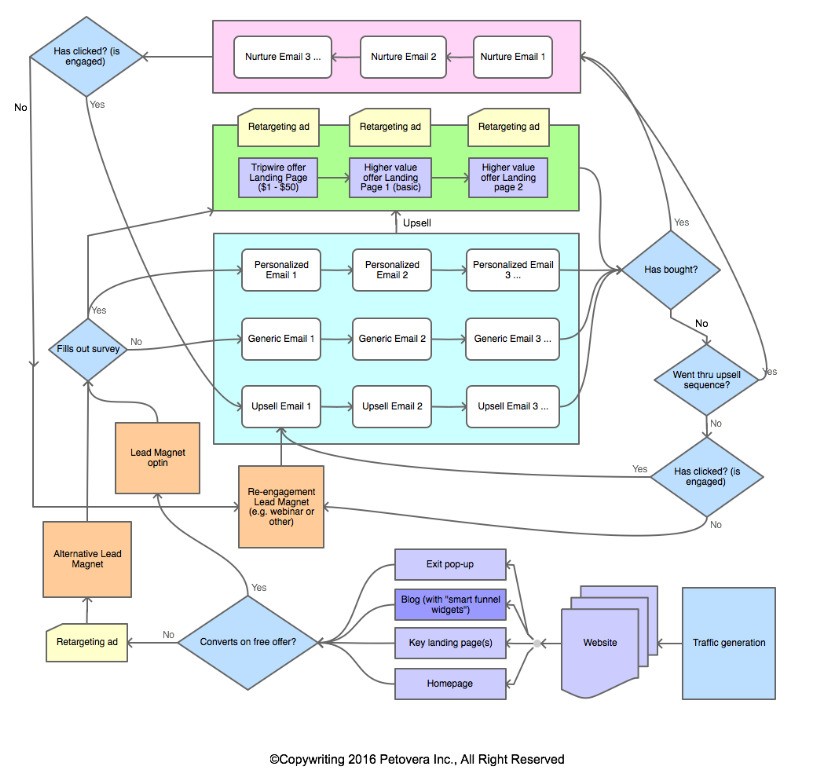
This is a great example of a complete sales funnel from Autogrow and Petovera that addresses the entire customer journey. It’ll help you build out a complete funnel that’ll help convert potential customers, retarget prospects, and upsell your existing customers for improved customer lifetime value. You can find more information and download the template here.
2. Clickfunnels’ High-Ticket Clients Funnel

This purchasing funnel from Clickfunnels will help you snag high-ticket clients from your target audience. If you focus on making your product or service affordable, this one wouldn’t be of much use to you. But it can be adapted to any company’s sales model and customer behavior patterns.
3. FitSmallBusiness Templates
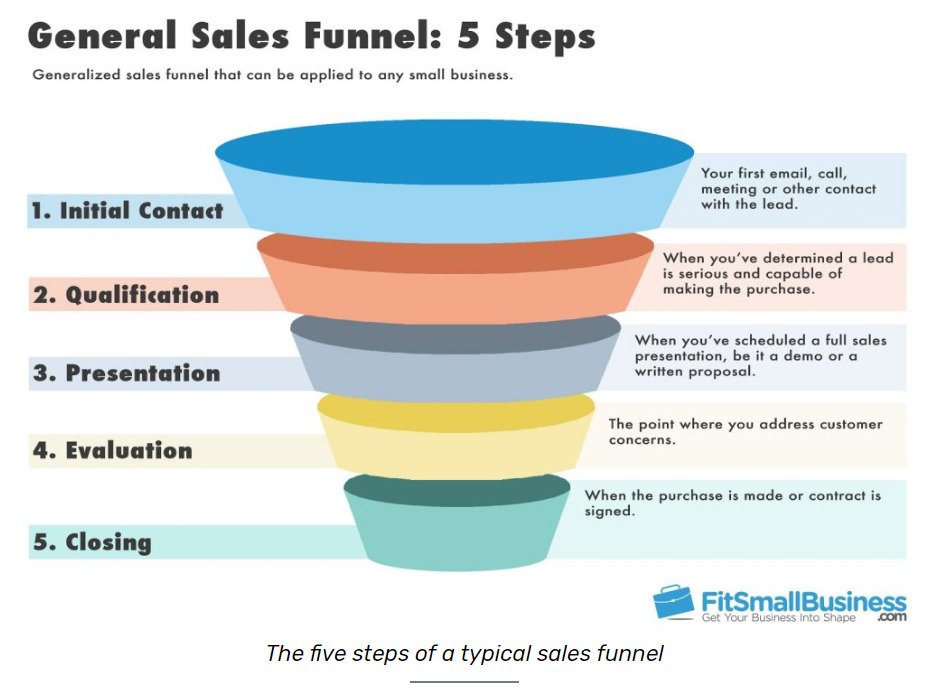
FitSmallBusiness has two sales funnel templates here designed for different customer preferences. One is a 5-stage funnel (pictured above) and the other is a 7-stage funnel.
Both are great for different sales funnel strategies, and each fits different preferences and business models. For example, if you have a simple offering for your target customers, a 5 stage funnel might be all you need. If not, the 7-stage template could suit your sales pipeline and customer behavior better.
4. HubSpot’s Sales Funnel Template
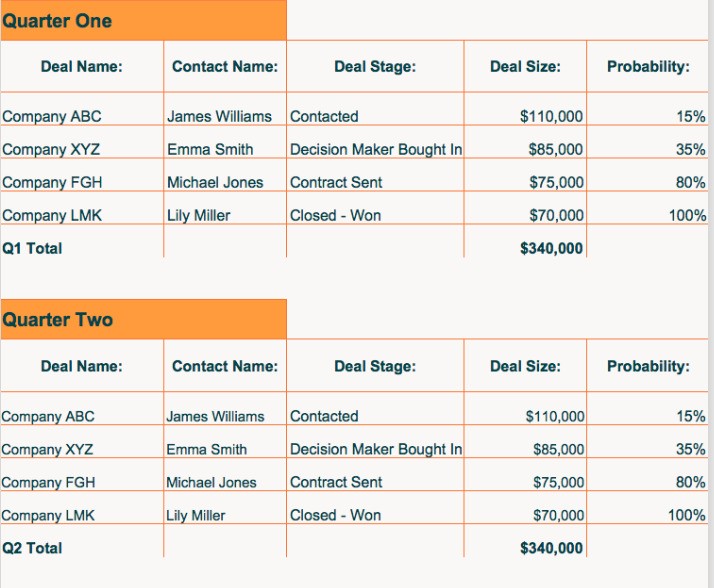
HubSpot has built up a great reputation over the years for understanding customer engagement and sales funnel metrics. So you’d expect top quality from them in all they do for target customers.
This sales funnel template of theirs is no different and focuses on effective customer interactions throughout the buying funnel.
5. Clickfunnels’ Free Book and Shipping Funnel
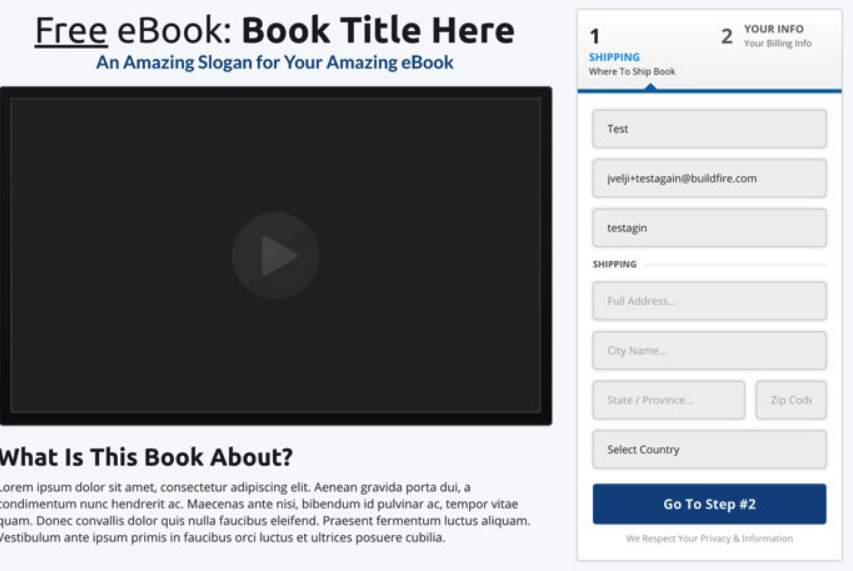
Publishing a book can establish your authority in your market and build strong brand loyalty with your target audience. But getting people to buy your book is a different story that requires effective marketing tactics.
The good news is that this customer funnel will help you connect readers to your book—at virtually no cost to you through strategic marketing efforts. It’s designed to cover shipping, manufacturing, and low-end advertising costs while boosting your authority as an expert and generating qualified leads for future customer engagement.
Try it here to see how it can work for your target customers.
Sales Funnel Tools
Clickfunnels

Clickfunnels helps you on both ends of your sales funnel work. It offers landing pages, sales pages, and more tools to engage potential customers throughout their customer journey.
However, your email marketing should be managed through a different portal for optimal customer data management and customer engagement.
All the above templates are housed in Clickfunnels, which demonstrates the platform’s power to build effective sales funnel strategies. There are hundreds of templates around Clickfunnels that you can use for anything your business is trying to achieve with your target customers.
Wishpond
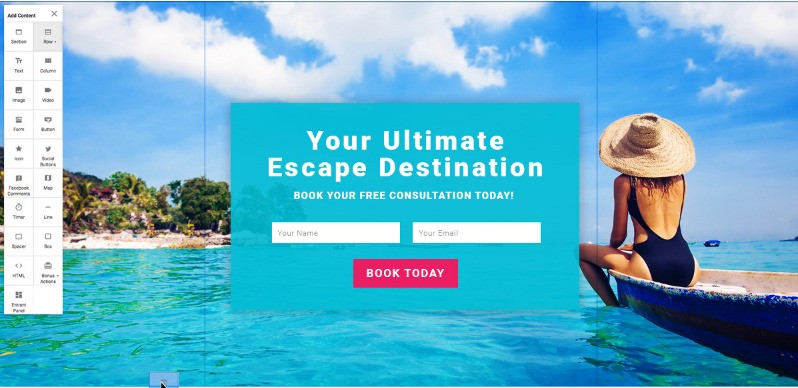
Wishpond helps you throughout your entire customer funnel and customer lifecycle—from landing pages to email marketing that nurtures leads effectively.
It simplifies funnel creation and gives you a central place to manage all your sales funnel activities and customer interactions with your target audience.
HubSpot
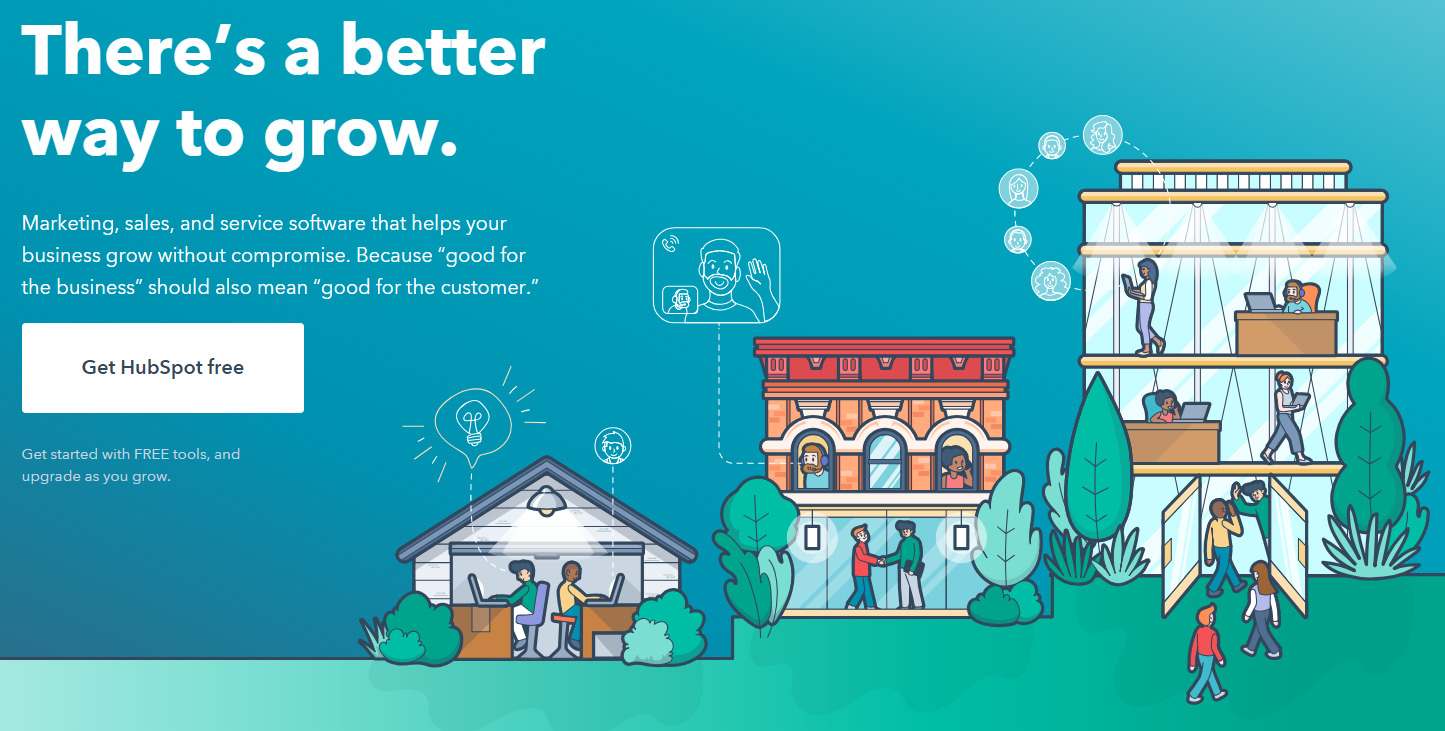
Hubspot also helps you throughout your entire customer funnel and sales pipeline management. And there’s a free forever plan too for small businesses looking to build their sales funnel.
But when it comes to premium accounts, HubSpot is one of the more expensive solutions for comprehensive customer data management. However, it’s well-suited to the needs of larger business-to-business companies with complex sales funnel strategies.
UpLead
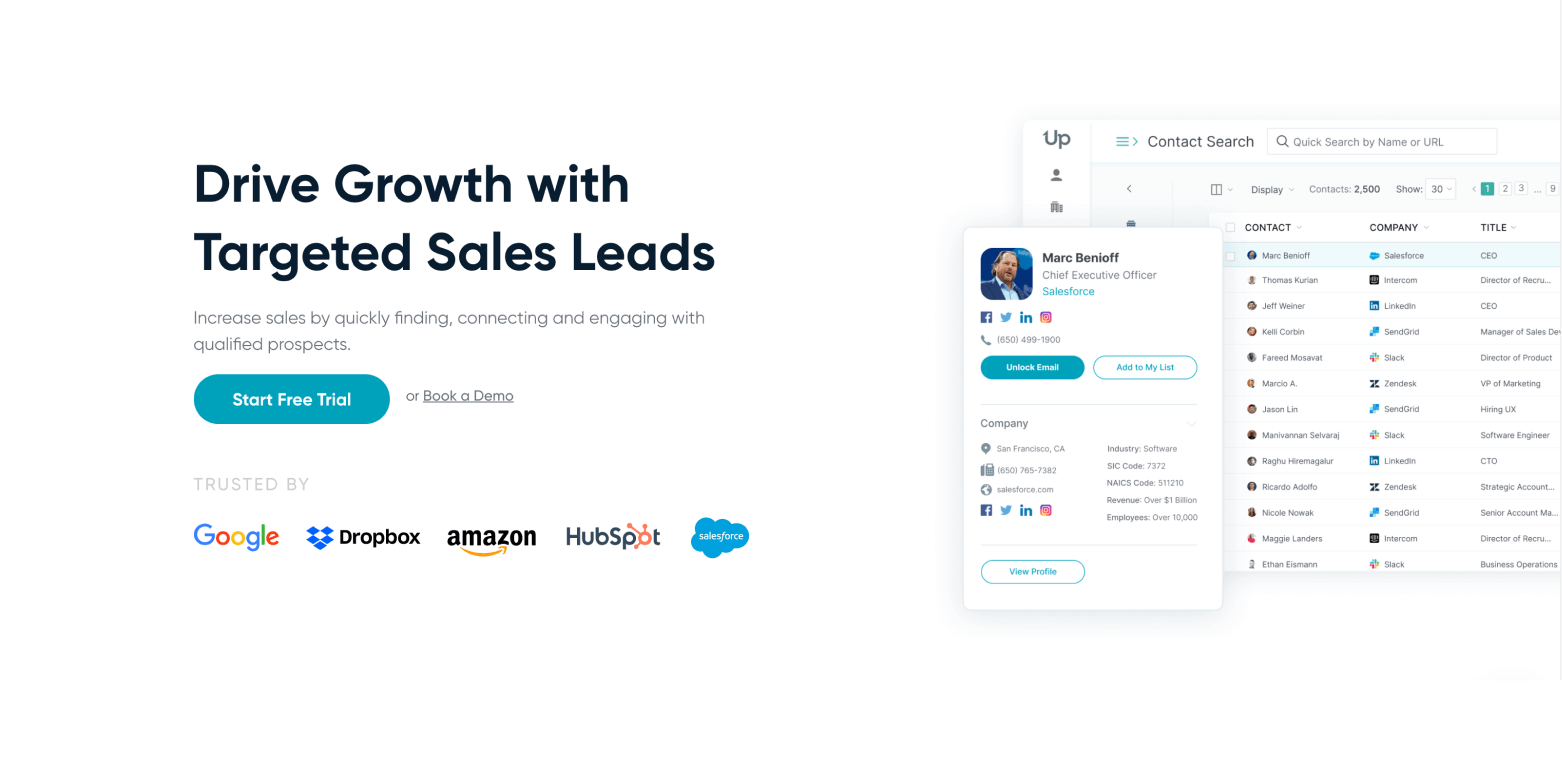
UpLead helps you fill the front end of your customer funnel with qualified leads from your target audience. Placing a huge emphasis on quality leads helps keep those conversion rates high and creates loyal customers through effective customer engagement.
If you don’t have qualified leads, your sales funnel is useless, which is why a good lead generation platform (such as UpLead) is crucial to your sales funnel’s success and business growth.
Instapage
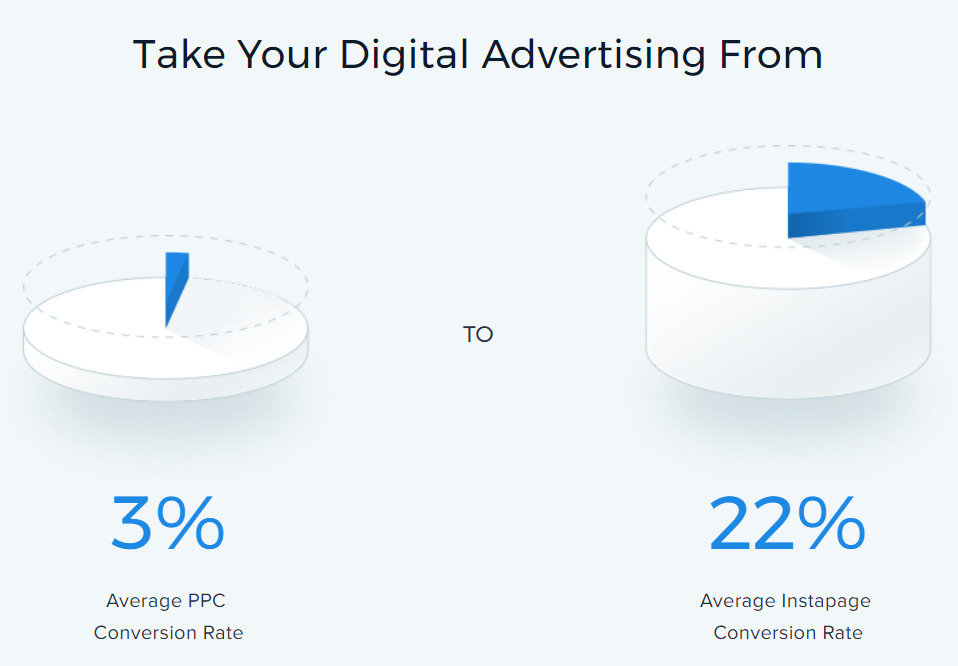
Instapage competes with Clickfunnels by helping you set up your sales funnel’s web pages and landing pages that convert potential buyers into paying customers.
Instapage has an easy-to-use page builder and a host of other features that’ll help you build the perfect web page for your target customers and optimize customer engagement.
When it comes to selecting the right page builder for your website and sales funnel strategies, there are many options. But since most offer free trials, it’s best to test them with your target audience and decide for yourself based on customer feedback and performance metrics.
Sales Funnels: Back to You
A solid, effective sales funnel is essential to growing your business and converting prospective customers into loyal customers. You’ve now learned all the necessary information you need to get started and create one of your own: what a sales funnel is, what the different sales funnel stages are, how to build a sales funnel that addresses customer pain points, and what sales funnel metrics to follow to optimize customer engagement.
Using the templates and tools above will help you optimize your customer funnel, automating and streamlining your sales process while improving customer retention. The only thing left to do is go out and build your sales funnel for your target customers! It may take some trial and error based on customer behavior and preferences, but one thing is certain: you could be losing out on revenue without a proper sales funnel that effectively nurtures leads through strategic marketing and sales efforts.
Remember that a successful sales funnel requires understanding your buyer personas, addressing their specific pain points, creating valuable content marketing that guides them through each stage of the sales process, and continuously optimizing based on customer data and feedback. Whether you’re focused on social media, email, or content marketing, your sales funnel plays an important role in creating meaningful customer interactions that build trust and drive business growth.
The key to sales success lies in understanding that your sales funnel work never truly ends. Market trends change, customer preferences evolve, and your sales funnel strategies must adapt accordingly. By focusing on customer lifetime value, improving customer retention, and consistently delivering value that addresses customer pain points, you’ll build not just a successful sales funnel, but a sustainable business that turns satisfied customers into advocates who fuel your continued growth through positive customer engagement and referrals.

